Vögel für FOK Theorie Wald I
Schwanzmeise am Pfäffikersee 2021-02-05 13.32.24 Pfäffikersee
Zuerst beobachtet in 🇨🇭 an 2020-04-13.
Vogelwarte.ch beschreibt genau was ich am Hungerseeli gesehen habe:
'Die Schwanzmeise zählt zu den kleinsten Vogelarten, scheint allerdings durch den langen Schwanz und das aufgeplusterte Gefieder grösser.'
Wikipedia schreibt,
Aussehen und Identifizierung: ![]() Bei uns in der Schweiz gibt's die Unterart europaeus,
mit breiten dunklen Streifen ueber den Augen.
'Die Schwanzmeise ist nicht enger mit den echten Meisen verwandt.' [Link]
Bei uns in der Schweiz gibt's die Unterart europaeus,
mit breiten dunklen Streifen ueber den Augen.
'Die Schwanzmeise ist nicht enger mit den echten Meisen verwandt.' [Link]
Song: high tsee-tsee; funny downhill trill
Habitate:
Wald
Gesang:
General: Meistens hoert man das Pfief...chk..chk..Pfief von den Rufen, siehe dort.
Song: Nabu: Der Gesang ist ein feines Trillern und selten zu hören (someone at XenoCanto compares it to a blue tit trill). [Link]
Gesang Eigenschaften:
Eselsbrücke Diddly doot-doot-doot-doot Melody: stereotypisch melodisch, langsam, Frequency: high (3-9 KHz)
♫ Quelle: XENOCANTO
XC572437 - Long-tailed Tit - Aegithalos caudatus - song.mp3
(Gesang)

Ruf:
![]() Die fast ständig geäusserten, hohen Rufe verraten die kleinen, rastlosen Turner im Gezweig meist schon, bevor sie zu sehen sind. [Link]
Die fast ständig geäusserten, hohen Rufe verraten die kleinen, rastlosen Turner im Gezweig meist schon, bevor sie zu sehen sind. [Link]
Flight call from XenoCanto
♫ Flight call from XenoCanto Quelle: XENOCANTO
XC517804 Long-tailed tit flight call.mp3
(Flugruf)

Ruf Eigenschaften:
Flugruf Ruf Melodie: einfach rhythmisch, langsam, Frequenz: high (3-9 KHz),
This fellow is singing in a bush across the street from us, at Bahnhofstrasse 18 They seldom like to show themselves, so I was pleased to see him. 2020-04-15 09.20.34 Bahnhofstrasse 18
Zuerst beobachtet in 🇨🇭 an 2019-08-30.
On a tree branch, but not usually on the treetop.
Etymologie: ![]() Häufig vorkommender, kleiner, grau-weisser Vogel mit schwarzem Mönchs-Tonsur.
Der Name hat weder mit Gras, noch mit Mücken zu tun! Es stammt nach Wikipedia 'aus dem Althochdeutschen von Gra-smucka = Grauschlüpfer'. [Link]
Häufig vorkommender, kleiner, grau-weisser Vogel mit schwarzem Mönchs-Tonsur.
Der Name hat weder mit Gras, noch mit Mücken zu tun! Es stammt nach Wikipedia 'aus dem Althochdeutschen von Gra-smucka = Grauschlüpfer'. [Link]
Gesang: ![]() Mit schwätzendem Vorgesang, (kann auch kurz sein oder ganz fehlen) der dann in klare, kräftige, zum Ende hin in wehmütige Flötentöne übergeht (Überschlag)
[Link]
Mit schwätzendem Vorgesang, (kann auch kurz sein oder ganz fehlen) der dann in klare, kräftige, zum Ende hin in wehmütige Flötentöne übergeht (Überschlag)
[Link]
![]() Song pleasing, varied and loud. Sometimes very similar to Garden Warbler. A typical phrase starts with soft, staccato chattering and mimicry, which after a few seconds changes to a much louder, pure and resonant stream of notes for about 3-5 seconds. No fixed motif, but may end phrases with recurring notes. Often deviates from the characteristic type of song, and identification from song alone may be impossible. May sing first part of song for extended periods without ever reaching the characteristic ending. [Link]
Song pleasing, varied and loud. Sometimes very similar to Garden Warbler. A typical phrase starts with soft, staccato chattering and mimicry, which after a few seconds changes to a much louder, pure and resonant stream of notes for about 3-5 seconds. No fixed motif, but may end phrases with recurring notes. Often deviates from the characteristic type of song, and identification from song alone may be impossible. May sing first part of song for extended periods without ever reaching the characteristic ending. [Link]
Rufe: ![]() „täck“ oft wiederholt
[Link]
„täck“ oft wiederholt
[Link]
![]() Alarm call a hard "check", similar to Lesser White-throat. Sometimes with an additional hoarse and nasal "cherrrr". [Link]
Alarm call a hard "check", similar to Lesser White-throat. Sometimes with an additional hoarse and nasal "cherrrr". [Link]
Körperlich: Länge=13 cm,
Flügelspanne=20-23 cm,
Gewicht=16-25 g
Habitate:
Wald
Gesang:
They sometimes sing like a blackbird on speed - also non-stereotypic, seemingly improvised,
in short bursts.
Our local guy ends most of his songs with the same seven notes, which I find a good way to confirm the identification. In Ticino we often heard the 'Leiern' sound - the warblers would sing just the first 3 notes of a longer song, then stop. The order varied; high-medium-low I call 'Figaro' as in the opera, low-high-medium 'whiskey bar', as it sounded to me like the Kurt Weill lyrics, 'O-oh-show me-the-way to-the-next whis-ke-bar' - but the warbler usually stopped after 'way' or 'next' The British authors of The Sound Approach claim to hear 'a warblel and a whistle'.
Gesang Eigenschaften:
Melody: improvisiert melodisch (hml), schnell, Frequency: 2-5 KHz Special sounds: Mimikry Singing season: 03-01 - 07-31 Dawn chorus start, 45 minutes before dawn.
♫ Quelle: BirdNet
20210331_191200 birdnet 1356 - Eurasian Blackcap hml - 2021-03-31 19:12:00 - Eurasian Blackcap - Lugano.mp3
2021-03-31 19.12.00 Lugano (Gesang)
♫ Tenero, lokaler Moenchsgrasmuecke Gesang endet meistens mit hlhl oder hlhlh. ![]() Quelle: Zoom H6 2023-06-20 07.52.22 Bolle di Magadino (Gesang)
Quelle: Zoom H6 2023-06-20 07.52.22 Bolle di Magadino (Gesang)
Ruf:
General: Sputtery/stoney, but may have other calls too.
Call: ![]() The Blackcap may generate a perplexing variety of territorial calls, though the typical contact call is a hard, tongue-clicking "teck teck" which has a scolding quality to it. It's not dissimilar to the 'pebble-clacking' call of the Stonechat. [Suffex Wildlife Trust]
The Blackcap may generate a perplexing variety of territorial calls, though the typical contact call is a hard, tongue-clicking "teck teck" which has a scolding quality to it. It's not dissimilar to the 'pebble-clacking' call of the Stonechat. [Suffex Wildlife Trust]
Ruf Eigenschaften:
Ruf Melodie: einnotig, langsam, Frequenz: high (3-9 KHz), Spezielle Klänge: stottern/kieseln.
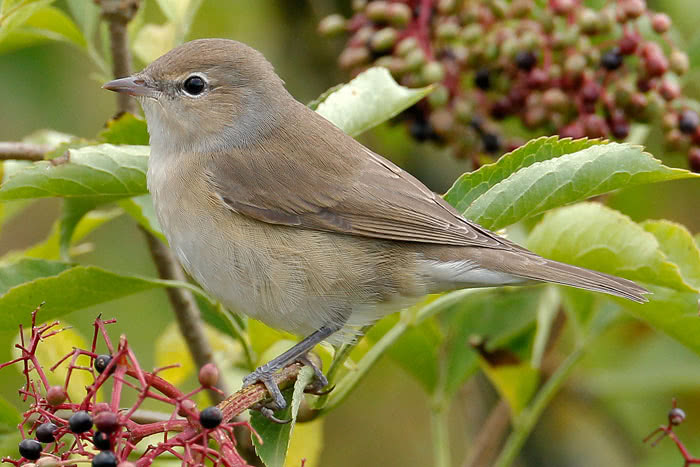
Vogelwarte Gartengrasmuecke. Quelle: VOGELWARTE
Vogelwarte Gartengrasmuecke.jpg
Zuerst beobachtet in 🇨🇭 an 2020-04-27.
Unauffällig, schüchtern. Ich höre sie viel beim Hungerseeli,
sehe sie praktisch nur als Schatten in den Ästen oder schnell zum nächsten
Baum fliegend.
Hidden in the branches. Does change trees though.
Aussehen und Identifizierung: Nabu: Das Hauptbestimmungsmerkmal dieser sehr unauffällig gefärbten Grasmücke ist,
dass sie kein besonderes Merkmal besitzt.
Im gegensatz zu ihrem Namen kommt die Gartengrasmücke
eher seltener in Gärten vor, häufiger ist sie in Hecken und grossen Büschen in waldrandlage anzutreffen, wo sie recht versteckt lebt. [Aus der NABU Android-App]
Gesang: ![]() Sprudelnd, orgelnd, die längsten Strophen aller hiesigen Grasmücken. Mit vielen reinen, volltönenden Tönen. Ohne Überschlag der Mönchsgrasmücke.
[Link]
Sprudelnd, orgelnd, die längsten Strophen aller hiesigen Grasmücken. Mit vielen reinen, volltönenden Tönen. Ohne Überschlag der Mönchsgrasmücke.
[Link]
![]() Song: a full bodied, flowing, melodious stream of notes, distinguished by its almost constant, warbled quality and lack of clear whistling notes (see Blackcap). Tempo is fairly even. Beware confusion possibility with occasional subsong of Blackcap that never reaches the whistling part! Call a nasal "che". [Link]
Song: a full bodied, flowing, melodious stream of notes, distinguished by its almost constant, warbled quality and lack of clear whistling notes (see Blackcap). Tempo is fairly even. Beware confusion possibility with occasional subsong of Blackcap that never reaches the whistling part! Call a nasal "che". [Link]
Rufe: ![]() Alarm call a hard "check", and a hoarse "tcherr". [Link]
Alarm call a hard "check", and a hoarse "tcherr". [Link]
Körperlich: Länge=14 cm,
Flügelspanne=20-24 cm,
Gewicht=16-22 g
Habitate:
Wald
Gesang:
Vogelwarte: 'minutenlang anhaltenden, plaudernden und abwechslungsreichen Gesang'
Gesang Eigenschaften:
Melody: improvisiert melodisch (hm), schnell, Frequency: medium (1-5 KHz)
♫ Quelle: XENOCANTO
XC728379 - Garden Warbler - Sylvia borin - song.png
(Gesang)
Präsenz: 04-15 - 10-05
Brut: 04-30 - 08-10
Migration rein: 04-15 - 05-30
Migration raus: 08-01 - 10-05
Profil Wikipedia eBird Vogelwarte BirdLife ZH ornitho.ch bird-song.ch Xeno-Canto BirdID NABU
Wintergoldhähnchen beim Meteorwasserkanal am Pfäffikersee. Endlich habe ich einen bei uns gesehen! 2020-10-30 16.44.10 Pfäffikersee
Zuerst beobachtet in 🇨🇭 an 2020-07-13.
Ein angeblicher häufig vorkommender Vogel bei Fehraltorf.
Ich habe sie lang nicht mal gehört, (den ähnlichen Sommergoldhähnchen hörte ich öfter im Sommer)
aber beim Pragelpass in einem Baum direkt ueberm Kopf gesehen
wie sie auf ihrer typischen Art (das weiss ich jetzt) vom Ast zu Ast
huepfen auf der Suche nach Insekten.
. In Dezember 2020 war ich vollbegeistert als eine Gruppe von 5 durch die
Buesche neben unserem Haus durchgezogen sind, und in jedem Busch und Baum nach
Insekten gesucht haben.
Gesang: ![]() Kurze Reihe von sehr hohen, leisen Tönen in auf-absteigender Tonhöhe, an das „W“-im Namen erinnernd. [Link]
Kurze Reihe von sehr hohen, leisen Tönen in auf-absteigender Tonhöhe, an das „W“-im Namen erinnernd. [Link]
![]() Song: a very high-pitched, undulating series of arpeggiated notes moving down and up again, repeated 4-5 times ending with a marked "conclusion" (like "trying to start a tiny motor and failing"). Timbre of song similar to contact call. [Link]
Song: a very high-pitched, undulating series of arpeggiated notes moving down and up again, repeated 4-5 times ending with a marked "conclusion" (like "trying to start a tiny motor and failing"). Timbre of song similar to contact call. [Link]
Rufe: ![]() 'sisisi' [Link]
'sisisi' [Link]
![]() Contact call a very high pitched "zit zit zit", only similar to Firecrest and treecreepers. Treecreepers usually calls with longer "zzzziiiiit" repeated at regular intervals, while Goldcrest calls in phrases with two to four calls in series in an uneven rhythm. Firecrest contact calls lower pitched than Goldcrest, and in a softer tone (but quite similar). [Link]
Contact call a very high pitched "zit zit zit", only similar to Firecrest and treecreepers. Treecreepers usually calls with longer "zzzziiiiit" repeated at regular intervals, while Goldcrest calls in phrases with two to four calls in series in an uneven rhythm. Firecrest contact calls lower pitched than Goldcrest, and in a softer tone (but quite similar). [Link]
Körperlich: Länge=9 cm,
Flügelspanne=13-15 cm,
Gewicht=4-7 g
Habitate:
Wald
Gesang:
![]() Vogelwarte.ch sagt, sehr hoher Gesang leicht auf- und absteigend. Hier faengt es mit flach an. [Link]
Vogelwarte.ch sagt, sehr hoher Gesang leicht auf- und absteigend. Hier faengt es mit flach an. [Link]
Gesang Eigenschaften:
Melody: stereotypisch melodisch, langsam, Frequency: 6-8 KHz
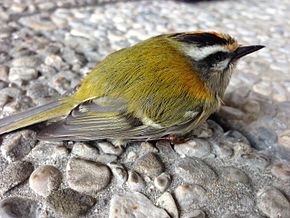
Wikipedia Sommergoldhaehnchen (Regulus ignicapilla) weiblich. Quelle: WIKIPEDIA
Wikipedia Sommergoldhaehnchen_(Regulus_ignicapilla) weiblich.jpg
Zuerst beobachtet in 🇨🇭 an 2020-05-09.
Allgemein: ![]() Das Sommergoldhähnchen (Regulus ignicapilla, Syn.: Regulus ignicapillus[1]) ist eine Vogelart der Gattung der Goldhähnchen (Regulus) aus der Familie Regulidae.
Das auf der Insel Madeira vorkommende Madeiragoldhähnchen (Regulus madeirensis) wurde mittlerweile als eigene Art anerkannt.
[more]
Das Sommergoldhähnchen (Regulus ignicapilla, Syn.: Regulus ignicapillus[1]) ist eine Vogelart der Gattung der Goldhähnchen (Regulus) aus der Familie Regulidae.
Das auf der Insel Madeira vorkommende Madeiragoldhähnchen (Regulus madeirensis) wurde mittlerweile als eigene Art anerkannt.
[more]
Vokalisierung: ![]() A slow crescendo of short "tze" sounds in a phrase rising slightly in pitch, without the repeated arpeggiated movements of goldcrest. [Link]
A slow crescendo of short "tze" sounds in a phrase rising slightly in pitch, without the repeated arpeggiated movements of goldcrest. [Link]
Gesang: ![]() Wie [beim Wintergoldhähnchen] aber auf gleicher Tonhöhe bleibend. [Link]
Wie [beim Wintergoldhähnchen] aber auf gleicher Tonhöhe bleibend. [Link]
![]() Song: Similar in timbre to Goldcrest, but much more monotonous. [Link]
Song: Similar in timbre to Goldcrest, but much more monotonous. [Link]
Rufe: ![]() „sisisi“ [Link]
„sisisi“ [Link]
![]() Call: a thin "tsi tsi tsi" similar to Goldcrest, but not so sharp. [Link]
Call: a thin "tsi tsi tsi" similar to Goldcrest, but not so sharp. [Link]
Körperlich: Länge=9 cm,
Flügelspanne=13-16 cm,
Gewicht=4-6 g
Habitate:
Wald
Gesang:
Very high rhythmic repetition of about 3 seconds
Gesang Eigenschaften:
Melody: einfach rhythmisch, schnell, Frequency: 6-8 KHz
In our back yard in Fehraltorf 2020-10-03 12.44.50 Luppmen
Zuerst beobachtet in 🇨🇭 an 2019-06-04.
In the survey of 2008, there was only 1 Chiffchaff in Fehraltorf for every 7 blackbirds, and it was ranked 19th in the village.
Yet in summer 2020 I heard them in nearly every recording I make, whether at home by the brook (Luppmen) or in the woods.
I presume their population has exploded in the last 10 years.
I see them in middle branches, but not in particularly exposed places.
Gesang: ![]() Von Mitte August bis Ende September bringt der Zilpzalp regelmäßig Herbstgesang dar. [Link]
Von Mitte August bis Ende September bringt der Zilpzalp regelmäßig Herbstgesang dar. [Link]
![]() Lange Reihen (6-20) von „zilp-zalp“-Rufen, meist abwechselnd in Tonhöhe. (Als bemühe sich der Sänger vergeblich den ersten Ton wieder zu treffen , ohne jedoch weit zu verfehlen.) „Zins zahl, Zins zahl, zahl Zins, Zins Zins zahl“ („Zins“ etwas höher als „zahl“) [Link]
Lange Reihen (6-20) von „zilp-zalp“-Rufen, meist abwechselnd in Tonhöhe. (Als bemühe sich der Sänger vergeblich den ersten Ton wieder zu treffen , ohne jedoch weit zu verfehlen.) „Zins zahl, Zins zahl, zahl Zins, Zins Zins zahl“ („Zins“ etwas höher als „zahl“) [Link]
![]() Song a very distinct: "chiff-chaff-chiff-chiff-chaff-chiff", in a regular clock-like rhythm. Each syllable at seemingly random pitch, but no large intervals tonally. Sometimes "get stuck" at one note. [Link]
Song a very distinct: "chiff-chaff-chiff-chiff-chaff-chiff", in a regular clock-like rhythm. Each syllable at seemingly random pitch, but no large intervals tonally. Sometimes "get stuck" at one note. [Link]
Rufe: ![]() Rufe :einsilbiges „hüid“, hinaufgezogen, wandelbar. [Link]
Rufe :einsilbiges „hüid“, hinaufgezogen, wandelbar. [Link]
![]() Contact/alarm call a soft, plaintive ascending "hooeet". Similar to W.Warbler, but shorter with a monosyllabic feel. [Link]
Contact/alarm call a soft, plaintive ascending "hooeet". Similar to W.Warbler, but shorter with a monosyllabic feel. [Link]
Körperlich: Länge=10-11 cm,
Flügelspanne=15-21 cm,
Gewicht=6-10 g
Habitate:
Wald
Gesang:
Seems to consist of 3 notes repeated randomly, occasionally just 2 notes.
Though NABU.de says they stop singing at the end of July, I do hear their 3-note song occasionally in October,
but just one or two repetitions.
Gesang Eigenschaften:
Melody: einfach rhythmisch, langsam, Frequency: high (3-9 KHz) Singing season: 03-01 - 07-31 Dawn chorus start, 35 minutes before dawn.
Ruf:
Repeated rising note, not too loud
♫ Quelle: XENOCANTO
XC656913 - Common Chiffchaff - Phylloscopus collybita - call recorded in Belgium.mp3
(Kontaktruf)

Ruf Eigenschaften:
Ruf Melodie: einnotig, langsam, Frequenz: 2-4 KHz, Spezielle Klänge: aufsteigend.
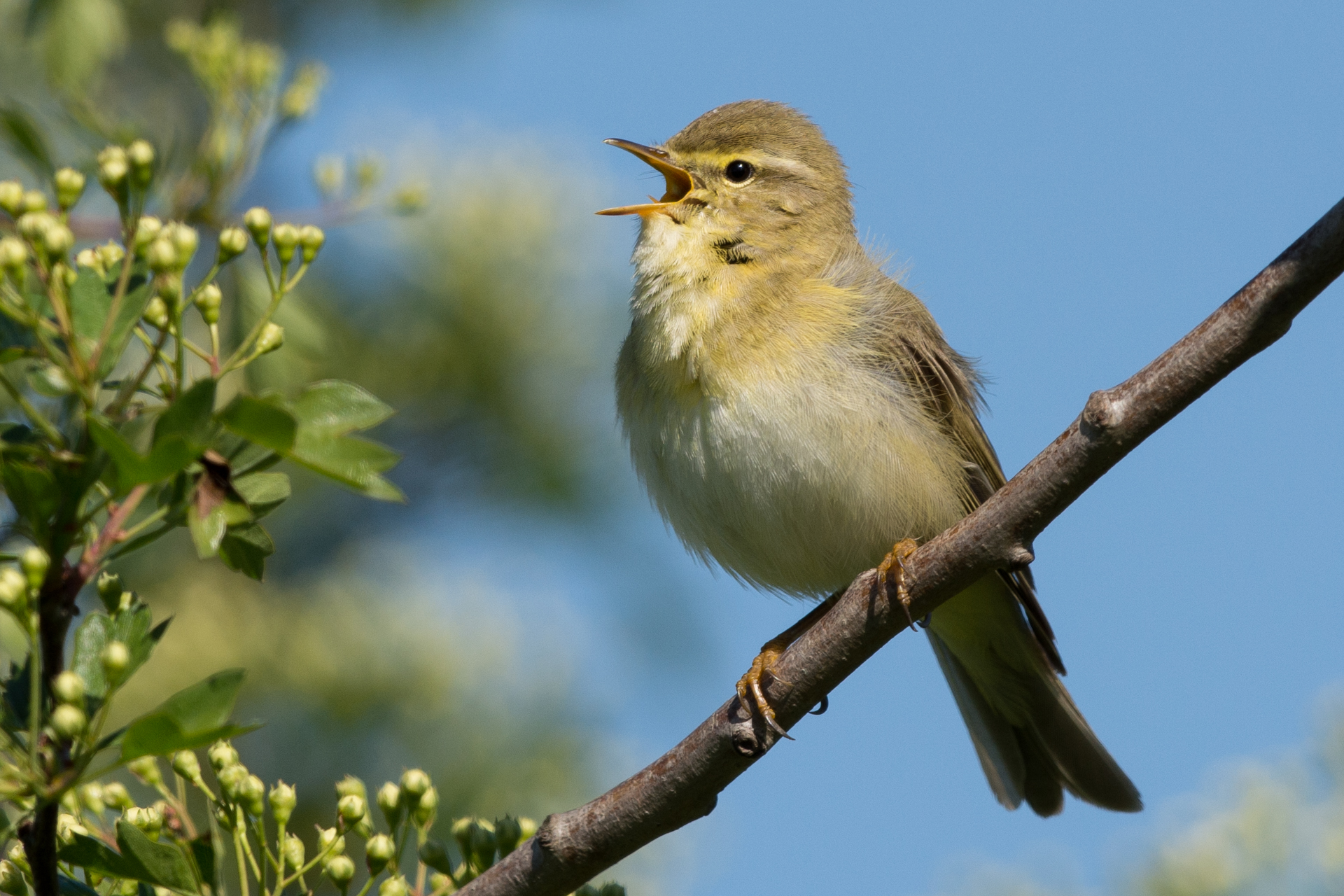
WikiCommons Fitis 13901013023. Quelle: WIKIPEDIA
WikiCommons Fitis 13901013023.jpg
Zuerst beobachtet in 🇨🇭 an 2020-04-24.
Allgemein: ![]() Der Fitis (Phylloscopus trochilus), auch Fitislaubsänger genannt, ist ein Singvogel aus der Gattung der Laubsänger (Phylloscopus) und der Familie der Laubsängerartigen (Phylloscopidae). Es werden mehrere Unterarten unterschieden. Die Nominatform Phylloscopus trochilus trochilus ist in Mitteleuropa ein verbreiteter und sehr häufiger Brut- und Sommervogel.
[more]
Der Fitis (Phylloscopus trochilus), auch Fitislaubsänger genannt, ist ein Singvogel aus der Gattung der Laubsänger (Phylloscopus) und der Familie der Laubsängerartigen (Phylloscopidae). Es werden mehrere Unterarten unterschieden. Die Nominatform Phylloscopus trochilus trochilus ist in Mitteleuropa ein verbreiteter und sehr häufiger Brut- und Sommervogel.
[more]
Gesang: ![]() Reihe v. Pfeiflauten (ca 12) etwas abfallend. Klingt ähnlich Buchfink, aber etwas traurig, melancholisch, wie in moll-Tonart. [Link]
Reihe v. Pfeiflauten (ca 12) etwas abfallend. Klingt ähnlich Buchfink, aber etwas traurig, melancholisch, wie in moll-Tonart. [Link]
![]() By far most easily identified by it's call or song. Song: A 3-5 second, falling phrase of soft, rippling "svi-svi" sounds, starting high with some attack, and then falling in a mellow manner. The phrase lacks any conclusion, and diminishes both in strength and tempo. [Link]
By far most easily identified by it's call or song. Song: A 3-5 second, falling phrase of soft, rippling "svi-svi" sounds, starting high with some attack, and then falling in a mellow manner. The phrase lacks any conclusion, and diminishes both in strength and tempo. [Link]
Rufe: ![]() ähnlich oben, aber mehr zweisilbig [Link]
ähnlich oben, aber mehr zweisilbig [Link]
![]() Contact/alarm call a soft, plaintive ascending "hoo-eet". Similar to Chiff-chaff, but first part more drawn, giving it a disyllabic feel. [Link]
Contact/alarm call a soft, plaintive ascending "hoo-eet". Similar to Chiff-chaff, but first part more drawn, giving it a disyllabic feel. [Link]
Körperlich: Länge=10-11 cm,
Flügelspanne=16-22 cm,
Gewicht=7-12 g
Habitate:
Wald
Gesang:
Gesang wie Buchfink aber höher, schnell, tendenz fallend aber mit mehr hoch und runter.
Gesang Eigenschaften:
Eselsbrücke Buchfink diva Melody: stereotypisch melodisch, schnell, Frequency: high (3-9 KHz) Singing season: 04-01 - 06-30 Dawn chorus start, 22 minutes before dawn.
Ruf:
Whoop very similar to chiffchaff, etc. but starts at an even level, then ascends.
Call recorded in UK, sounds typical to me, and spiced up by a yellowhammer in the background and several other birds
♫ Call recorded in UK, sounds typical to me, and spiced up by a yellowhammer in the background and several other birds Quelle: XENOCANTO
XC444002 - Willow Warbler - Phylloscopus trochilus trochilus - call in UK, with yellowhammer in background.mp3
(Ruf)

Ruf Eigenschaften:
Kontaktruf Ruf Melodie: einfach rhythmisch, langsam, Frequenz: 2-4 KHz, Spezielle Klänge: aufsteigend.
Profil Wikipedia eBird Vogelwarte BirdLife ZH ornitho.ch bird-song.ch Xeno-Canto BirdID NABU
Wahrscheinlich Waldlaubsänger. 2022-05-22 09.52.22 Leuk und Umgebung
Zuerst beobachtet in 🇨🇭 an 2022-05-22.
Allgemein: ![]() Der Waldlaubsänger (Phylloscopus sibilatrix) ist eine Vogelart der Gattung der Laubsänger (Phylloscopus) aus der Familie der Laubsängerartige (Phylloscopidae). Es werden keine Unterarten unterschieden.
[more]
Der Waldlaubsänger (Phylloscopus sibilatrix) ist eine Vogelart der Gattung der Laubsänger (Phylloscopus) aus der Familie der Laubsängerartige (Phylloscopidae). Es werden keine Unterarten unterschieden.
[more]
Gesang: ![]() kurze Reihe (4-10) v. Stakkatotönen, gefolgt von abfallendem Schwirrroller. (Tönt wie das Anlassen eines Velosolex) Während des Gesanges schwebender Schwirrflug. Dazu hört man eine Reihe angenehmer Pfeiflaute wie „djü“ [Link]
kurze Reihe (4-10) v. Stakkatotönen, gefolgt von abfallendem Schwirrroller. (Tönt wie das Anlassen eines Velosolex) Während des Gesanges schwebender Schwirrflug. Dazu hört man eine Reihe angenehmer Pfeiflaute wie „djü“ [Link]
![]() Song distinct. An accelerating series of sharp, metallic "swee-swee-swee-swee". Alternative (piping) song a series of 4-6 piping, plaintive and descending "pew - pew" calls. Resembles Willow Tit's song, but is softer with each note more evenly pitched. Contact call similar to individual syllables of piping song, but with heavier accent on the ending. [Link]
Song distinct. An accelerating series of sharp, metallic "swee-swee-swee-swee". Alternative (piping) song a series of 4-6 piping, plaintive and descending "pew - pew" calls. Resembles Willow Tit's song, but is softer with each note more evenly pitched. Contact call similar to individual syllables of piping song, but with heavier accent on the ending. [Link]
Rufe: ![]() „düü“ [Link]
„düü“ [Link]
![]() Typically with a staccato beginning. Pitch drops as the speed increases and the syllables fuses into a continuous trill. Often described as the sound of a spinning coin coming to rest on a glass table. Some phrases may be given in an almost even tempo, and may recall Bonelli's Warbler. [Link]
Typically with a staccato beginning. Pitch drops as the speed increases and the syllables fuses into a continuous trill. Often described as the sound of a spinning coin coming to rest on a glass table. Some phrases may be given in an almost even tempo, and may recall Bonelli's Warbler. [Link]
Körperlich: Länge=12 cm,
Flügelspanne=19-24 cm,
Gewicht=8-12 g
Habitate:
Wald
Gesang:
Sid-sid-sid-sirrrr. 3 secs, then 5 secs pause. At bird-song.ch I hear a slow-fast one-noter, about 8 slow ones in 1.5 seconds, then a trill of 25 fast ones.
Gesang Eigenschaften:
Melody: einfach rhythmisch, schnell, Frequency: 5-8 KHz Special sounds: Triller
♫ Quelle: XENOCANTO
XC727564 - Wood Warbler - Phylloscopus sibilatrix - song.mp3
(Gesang)
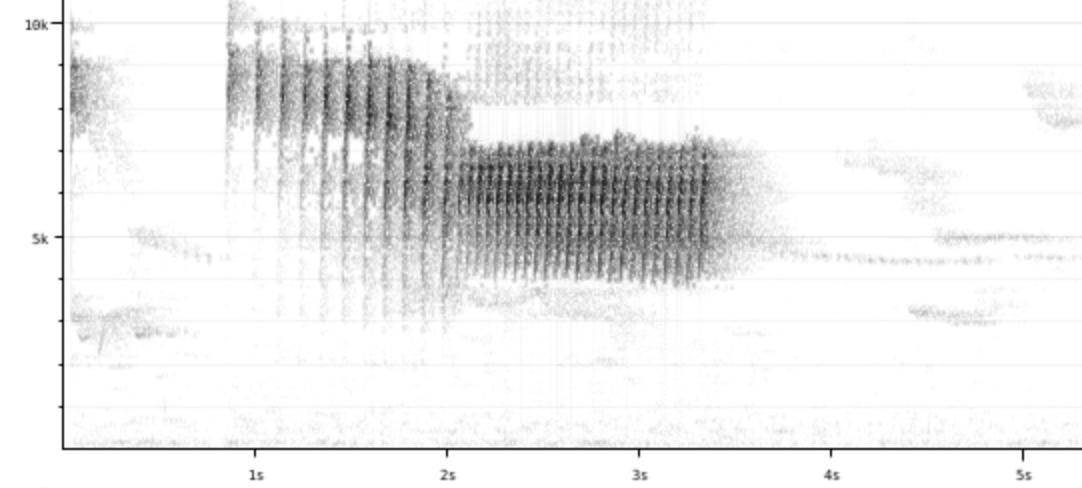
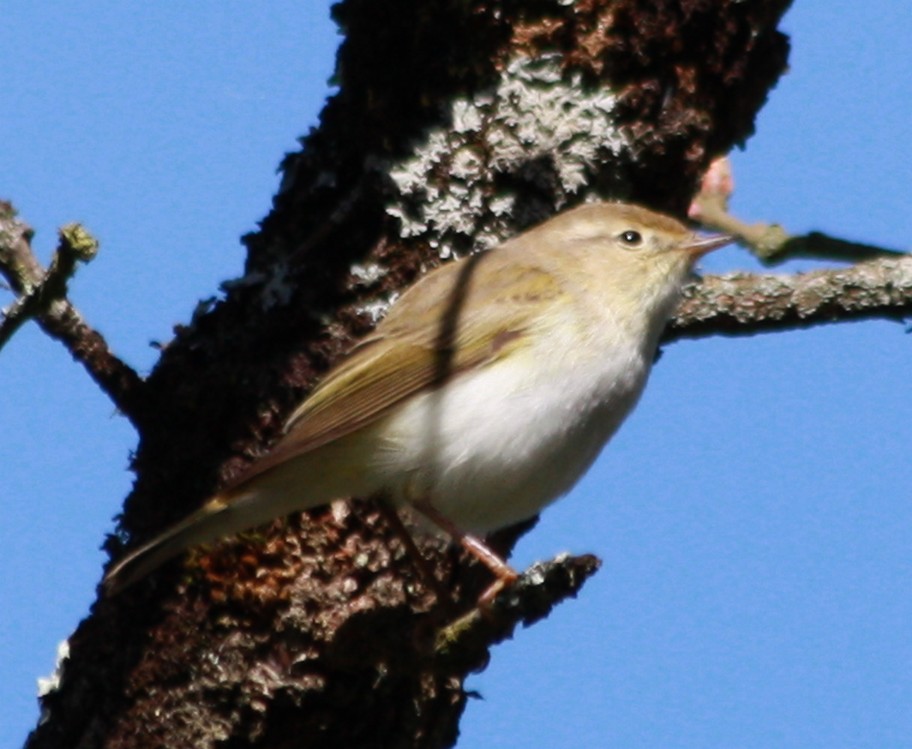
Wikipedia Berglaubsaenger Phylloscopus bonelli. From Sébastien Bertru - https://www.flickr.com/photos/aigledayres/5911604938/, CC BY-SA 2.0, Link Quelle: WIKIPEDIA
Wikipedia Berglaubsaenger Phylloscopus_bonelli.jpg
Zuerst beobachtet in 🇨🇭 an 2020-06-08.
Roman von Sury findet sie schön aber sie verlieren ihr Habitat in der Schweiz.
Gesang: ![]() Reihe(5-10) von gleichhohen Schlägen, ähnlich dem Schwirren der obigen Art [Waldlaubsänger], aber langsamer, einzelne Töne deutlich getrennt, etwas scheppernd. Kann mit Klappergrasmücke verwechselt werden) [Link]
Reihe(5-10) von gleichhohen Schlägen, ähnlich dem Schwirren der obigen Art [Waldlaubsänger], aber langsamer, einzelne Töne deutlich getrennt, etwas scheppernd. Kann mit Klappergrasmücke verwechselt werden) [Link]
Habitate:
Wald
Gesang:
Single note repeated 6 or 8 times quickly in half a second
Gesang Eigenschaften:
Melody: einnotig, schnell, Frequency: 3-7 KHz
♫ Quelle: XENOCANTO
XC720128 - Western Bonelli's Warbler - Phylloscopus bonelli - song, recorded in France.mp3
(Gesang)

Profil Wikipedia eBird Vogelwarte BirdLife ZH ornitho.ch bird-song.ch Xeno-Canto BirdID NABU
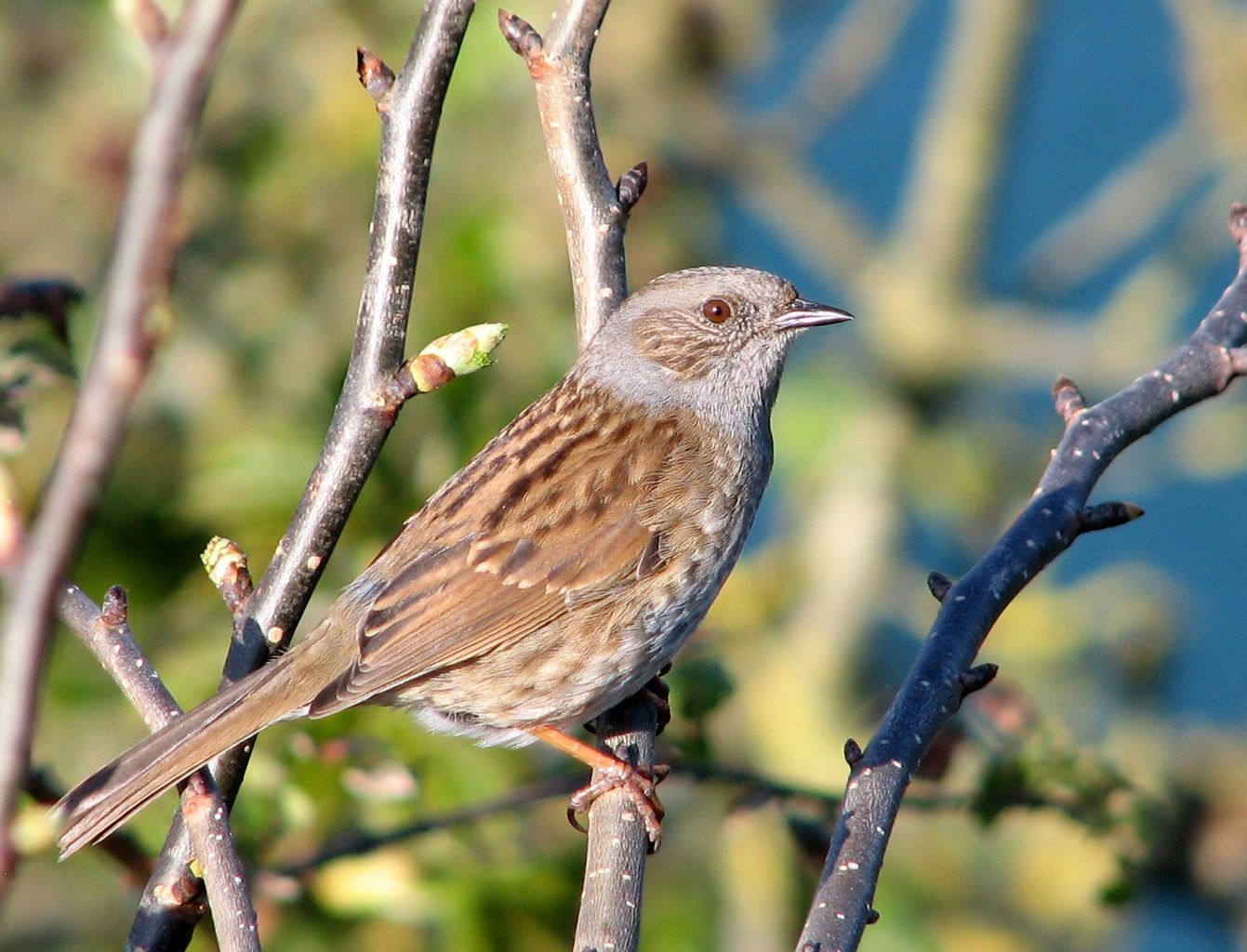
Wikpedia photo because mine is poor. Quelle: WIKIPEDIA
Dunnock oder Heckenbraunelle aus Wikipedia weil nur gehört.jpg
Zuerst beobachtet in 🇨🇭 an 2020-04-16.
Heard at Hungerseeli and near Lendikon according to BirdNET. Finally seen near Amden 2023.
Gesang: ![]() Singt schon im Vorfrühling. Klangfarbe ähnlich Gartenbaumläufer. Aufbau ähnlich Zaunkönig, aber ohne Triller. Viel leiser und dünner.
[Link]
Singt schon im Vorfrühling. Klangfarbe ähnlich Gartenbaumläufer. Aufbau ähnlich Zaunkönig, aber ohne Triller. Viel leiser und dünner.
[Link]
![]() Song a fast and evenly paced, high pitched stream of clear notes. No consistent phrasing. Similar in timbre to Robin, but does not vary tempo or pitch nearly as much. Often compared to the sound of a squeaky wheelbarrow. [Link]
Song a fast and evenly paced, high pitched stream of clear notes. No consistent phrasing. Similar in timbre to Robin, but does not vary tempo or pitch nearly as much. Often compared to the sound of a squeaky wheelbarrow. [Link]
Rufe: ![]() Hohe „zi“ „tsi“. Auf dem Zug „zieht“. Etwas absinkend..
[Link]
Hohe „zi“ „tsi“. Auf dem Zug „zieht“. Etwas absinkend..
[Link]
![]() Contact call a dry, thick trill "trrr", and a short King Fisher-like, high-pitched "zeep". [Link]
Contact call a dry, thick trill "trrr", and a short King Fisher-like, high-pitched "zeep". [Link]
Körperlich: Länge=14 cm,
Flügelspanne=19-21 cm,
Gewicht=16-25 g
Habitate:
Wald
Gesang:
General: High-pitched, repetitive but complex little tune.
Song: ![]() Melodisch, slowly rising, roughly like black-cap warbler, which I guessed in the bird-song.ch quiz. [Link]
Melodisch, slowly rising, roughly like black-cap warbler, which I guessed in the bird-song.ch quiz. [Link]
Gesang Eigenschaften:
Melody: stereotypisch melodisch, schnell, Frequency: 4-8 KHz Singing season: 02-15 - 07-31 Dawn chorus start, 45 minutes before dawn.
Ruf:
Swooping staccato call 0.5 seconds long heard near Lendikon. Repeated irregularly after 1-3.5 seconds.
♫ Quelle: XENOCANTO
XC594397 - Dunnock - Prunella modularis modularis - call recorded in Poland.mp3
(Ruf)
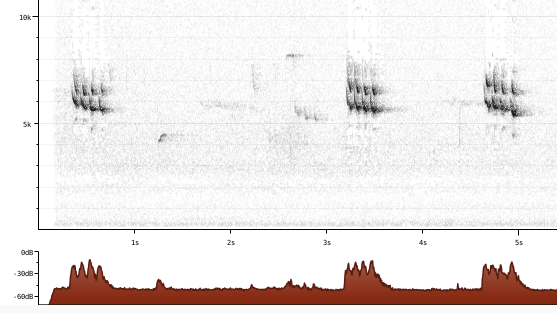
Ruf Eigenschaften:
Ruf Melodie: einnotig, schnell, Frequenz: 5-7 KHz, Spezielle Klänge: absteigend.
Profil Wikipedia eBird Vogelwarte BirdLife ZH ornitho.ch bird-song.ch Xeno-Canto BirdID NABU
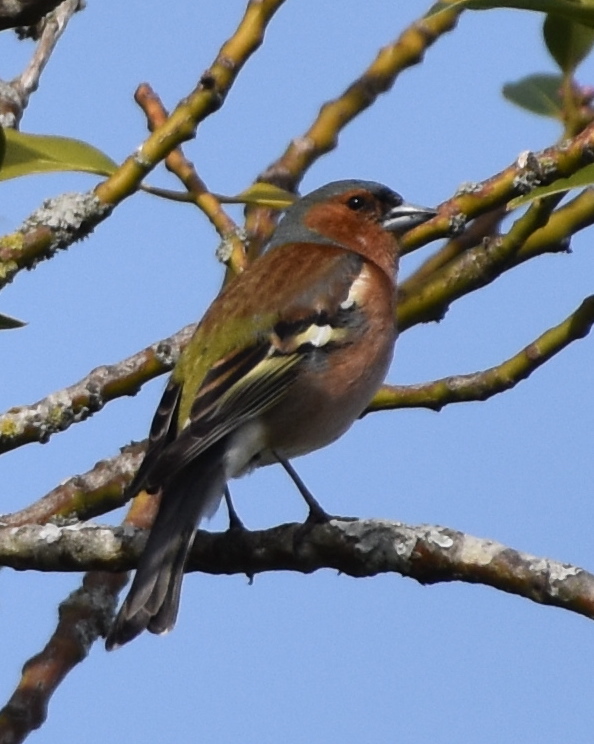
In tree by First, ZH. 2020-05-04 17.33.36 Luppmen
Zuerst beobachtet in 🇨🇭 an 2019-06-04.
Heard everywhere locally but less often seen.
In winter 2020-2021 it often accompanied tits to our feeder (2021-2022 less often). While they grabbed
sunflower seeds, the chaffinch would hunt for food on the ground or in bushes.
On Dec 8 2021, was surprised to see flocks of collared doves, chaffinches and a few sparrows in a harvested corn field as it was snowing. I wasn't aware that chaffinches formed flocks, but the Merlin BirdID app told me 'forms flocks in winter'.
I've caught it on stubby branches of an evergreen, in a lone tree in a farmyard, and in Brittany even on
a lightpost. And I seem to see one every time I go to Zurich, so they're happy in an urban setting.
Etymologie: ![]() Als Kontakt- und Alarmruf dient «pink», von dem wahrscheinlich die deutsche Bezeichnung «Fink» herkommt. [Von BirdLifes Schweizer 'bird song' Website]
Als Kontakt- und Alarmruf dient «pink», von dem wahrscheinlich die deutsche Bezeichnung «Fink» herkommt. [Von BirdLifes Schweizer 'bird song' Website]
Aussehen und Identifizierung: ![]() Interesting tidbit: the chaffinch is one bird
that can change colors without molting. Its new feathers in autumn are grayish, but by late spring
the edges of the feathers have worn away, revealing the chaffinch's brightest colors of the year. [Lovette and Fitzpatrick's Handbook of Bird Biology]
Interesting tidbit: the chaffinch is one bird
that can change colors without molting. Its new feathers in autumn are grayish, but by late spring
the edges of the feathers have worn away, revealing the chaffinch's brightest colors of the year. [Lovette and Fitzpatrick's Handbook of Bird Biology]
Gesang: ![]() Song a falling 5 sec. phrase "zitt-zitt-chep-chepp-chu-chu-churrurrwitt". Structurally similar to Willow Warbler, but with a conclusive, ascending and accented ending, and with a much harder, finch-like, timbre. [Link]
Song a falling 5 sec. phrase "zitt-zitt-chep-chepp-chu-chu-churrurrwitt". Structurally similar to Willow Warbler, but with a conclusive, ascending and accented ending, and with a much harder, finch-like, timbre. [Link]
Körperlich: Länge=14 cm,
Flügelspanne=24-28 cm,
Gewicht=18-29 g
Habitate:
Wald
Soziale Gruppen können bis 10 beinhalten.
Gesang:
General: A medium long phrase that slowly descends (I think of it bouncing down a staircase), then usually takes a
jump up before a final descent.
Song: ![]() In Bayern gilt als Merksatz des Buchfinken: „Ich hätte gerne ein Weizenbier“ [DasHaus]
In Bayern gilt als Merksatz des Buchfinken: „Ich hätte gerne ein Weizenbier“ [DasHaus]
Gesang Eigenschaften:
Melody: stereotypisch melodisch (mmmmmmmmLlhH), langsam, Frequency: medium (1-5 KHz) Singing season: 02-01 - 07-31 Dawn chorus start, 10 minutes before dawn.
♫ 2024-04-30 12 55 Fehraltorf - Buchfink Gesang-Variante, steigt am Schluss - mmmmmmmmLlhH. 2024-04-30 12.55.00 Fehraltorf (Gesang)
♫ Quelle: BirdNet
20210419_142922 birdnet 1449 - Common Chaffinch but who is the hhll behind him - Common Chaffinch - Fehraltorf.mp3
2021-04-19 14.29.22 Fehraltorf (Gesang)
Rufe:
1:
General: Repeated ascending note, faster than the long starling whoops, but compare with the black redstart.
There are many different calls, the Marler book describes the 'chink' call as functioning as a mobbing and separation call.
At XenoCanto I find calls described as "ping", "pik" (same thing?), "pchew", "duit", "huit", "ti-huit".
Call: ![]() Der sogenannte Regenruf der Männchen, „schrrüt“, der selbst in benachbarten Ortsteilen deutlich variieren kann, erklingt nur während der Brutzeit. Als Regenruf wird er bezeichnet, weil er kurz vor oder sogar während des Regens zu hören ist, wenn die anderen Vögel verstummen. [DasHaus]
Der sogenannte Regenruf der Männchen, „schrrüt“, der selbst in benachbarten Ortsteilen deutlich variieren kann, erklingt nur während der Brutzeit. Als Regenruf wird er bezeichnet, weil er kurz vor oder sogar während des Regens zu hören ist, wenn die anderen Vögel verstummen. [DasHaus]
Rain call from XenoCanto
♫ Rain call from XenoCanto Recorded by Paul Driver in Mundford, Norfolk, UK Quelle: XENOCANTO
XC71019 common chaffinch rain call.mp3
(Regenruf)
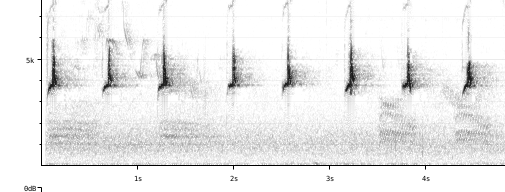
2:
Call: ![]() Als Alarmsignal dient ein mehrsilbiges „pink“. [DasHaus]
Als Alarmsignal dient ein mehrsilbiges „pink“. [DasHaus]
Ping call from XenoCanto
♫ Ping call from XenoCanto Quelle: XENOCANTO
XC460303 common chaffinch ping call.mp3
(Alarmruf)

Ruf Eigenschaften:
Regenruf Ruf Melodie: einnotig, langsam, Frequenz: 3-5 KHz, Spezielle Klänge: aufsteigend.
Präsenz: 01-01 - 12-31
Brut: 04-01 - 07-31
Migration rein: 02-20 - 04-15
Migration raus: 09-10 - 11-15
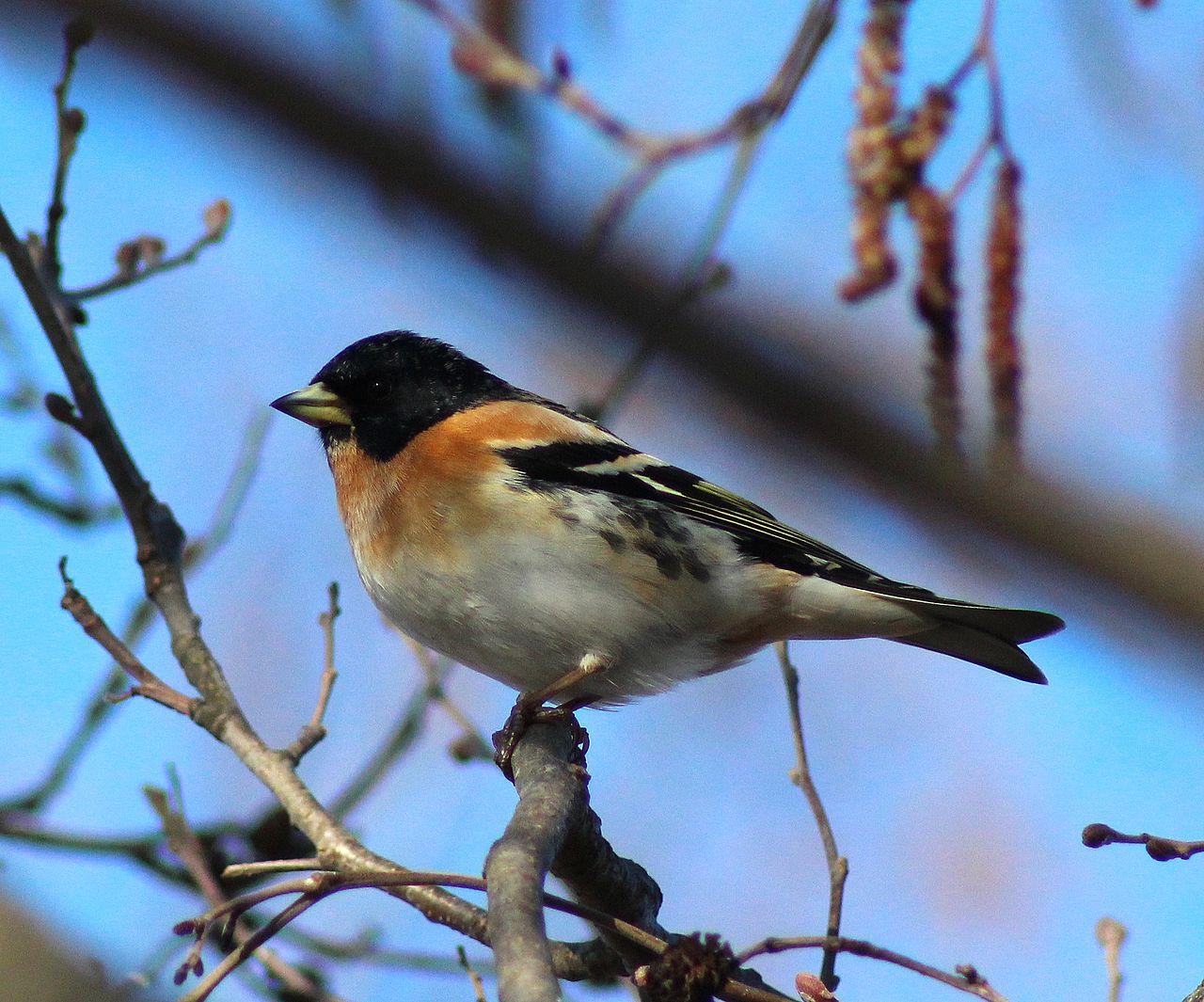
Wikipedia Bergfink. Foto: Quelle: WIKIPEDIA
Wikipedia Bergfink.jpg
Dieser Vogel erscheint jenseits grossen Meere in Kontinenten :
Europa, Nordamerika, Afrika.
Geographie: ![]() the Brambling appears regularly in small numbers in Alaska during migration, straying the short distance across the Bering Sea. Some of those that stray across in autumn apparently then continue south on the American side, and there have been winter records for numerous states and provinces east to the Atlantic Coast and south to Colorado. Many of these vagrant Bramblings have been found visiting bird feeders. [Link]
the Brambling appears regularly in small numbers in Alaska during migration, straying the short distance across the Bering Sea. Some of those that stray across in autumn apparently then continue south on the American side, and there have been winter records for numerous states and provinces east to the Atlantic Coast and south to Colorado. Many of these vagrant Bramblings have been found visiting bird feeders. [Link]
Vokalisierung: ![]() Large repertoire of mostly characteristic sounds. [Link]
Large repertoire of mostly characteristic sounds. [Link]
Gesang: ![]() Song very distinct; a soft, wheezing, drawn-out single note. Repeated at the same pitch in a monotonous manner. [Link]
Song very distinct; a soft, wheezing, drawn-out single note. Repeated at the same pitch in a monotonous manner. [Link]
Rufe: ![]() Contact calls include a short, nasal, ascending "keeaa", a short high-pitched, piercing "tzeet" and a linnet-like "chepp". May be mistaken for Greenfinch, but note softer timbre and stable pitch throughout the call. [Link]
Contact calls include a short, nasal, ascending "keeaa", a short high-pitched, piercing "tzeet" and a linnet-like "chepp". May be mistaken for Greenfinch, but note softer timbre and stable pitch throughout the call. [Link]
Körperlich: Länge=14 cm,
Flügelspanne=25-26 cm,
Gewicht=17-30 g
Habitate:
Wald
Gesang:
General: Bergfink - call cheep plus two ascending Grünfink squawks. Song? Grünfink squawk but not descending, every 3-4 seconds.
Song: ![]() Song very distinct; a soft, wheezing, drawn-out single note. Repeated at the same pitch in a monotonous manner. [Link]
Song very distinct; a soft, wheezing, drawn-out single note. Repeated at the same pitch in a monotonous manner. [Link]
Gesang Eigenschaften:
Melody: einfach rhythmisch, langsam, Frequency: medium (1-5 KHz) Special sounds: Raspel Singing season: 04-14 - 09-15
♫ Quelle: XENOCANTO
XC731031 - Brambling - Fringilla montifringilla.mp3
(Gesang)
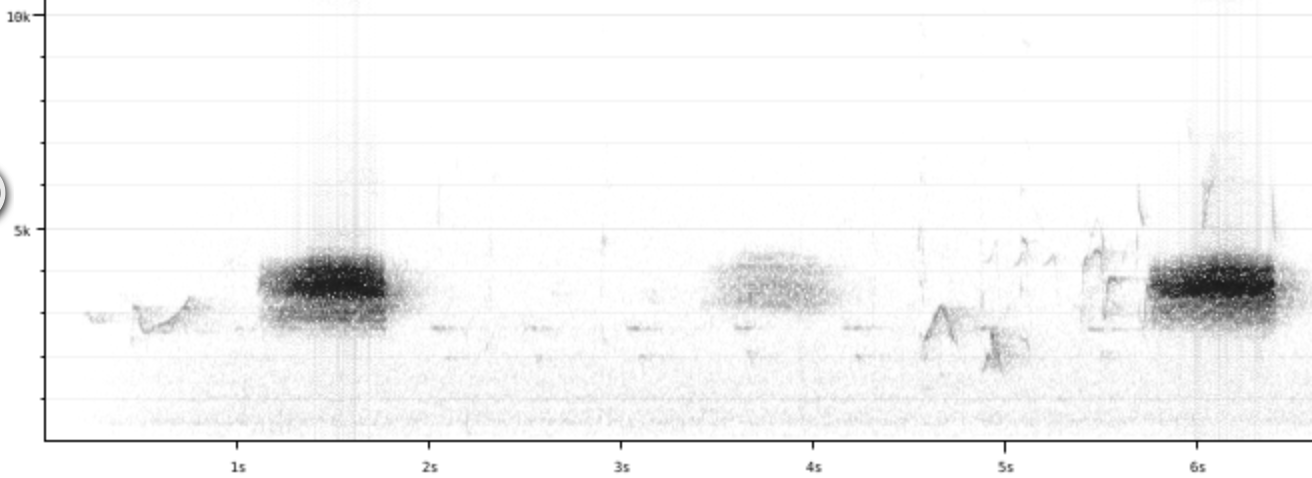
Profil Wikipedia eBird Vogelwarte BirdLife ZH ornitho.ch bird-song.ch Xeno-Canto BirdID NABU
Gimpel gesehen das erste Mal, Ammler Höhenweg. 2021-08-02 15.55.56
Zuerst beobachtet in 🇨🇭 an 2021-02-21.
Allgemein: ![]() Der Gimpel (Pyrrhula pyrrhula), auch Dompfaff oder seltener Blutfink genannt, ist eine Vogelart aus der Familie der Finken (Fringillidae). Er besiedelt Europa, Vorderasien, Ostasien einschließlich Kamtschatka und Japan sowie Sibirien. Sowohl im Tiefland als auch in Bergwäldern lebt der Gimpel im Nadelwald, überwiegend in Fichten-Schonungen, aber auch in lichten Mischwäldern mit wenig Nadelbäumen oder Unterholz. Seine Nahrung setzt sich aus halbreifen und reifen Samen von Wildkräutern und Knospen zusammen. Die Art gilt derzeit als nicht gefährdet.
[more]
Der Gimpel (Pyrrhula pyrrhula), auch Dompfaff oder seltener Blutfink genannt, ist eine Vogelart aus der Familie der Finken (Fringillidae). Er besiedelt Europa, Vorderasien, Ostasien einschließlich Kamtschatka und Japan sowie Sibirien. Sowohl im Tiefland als auch in Bergwäldern lebt der Gimpel im Nadelwald, überwiegend in Fichten-Schonungen, aber auch in lichten Mischwäldern mit wenig Nadelbäumen oder Unterholz. Seine Nahrung setzt sich aus halbreifen und reifen Samen von Wildkräutern und Knospen zusammen. Die Art gilt derzeit als nicht gefährdet.
[more]
Gesang: ![]() Song a quiet, modest mix of contact call and various chirping sounds, with peculiar harmonics. [Link]
Song a quiet, modest mix of contact call and various chirping sounds, with peculiar harmonics. [Link]
Rufe: ![]() Contact call a soft, full-bodied, descending, pure whistle; "peeuu". [Link]
Contact call a soft, full-bodied, descending, pure whistle; "peeuu". [Link]
Körperlich: Länge=14-16 cm,
Flügelspanne=22-29 cm,
Gewicht=27-38 g
Habitate:
Wald
Gesang:
3-note long M, pause, HL (somewhat falling)...Gim! Gim-peeel! Sounds a bit like a pirol.
Gesang Eigenschaften:
Melody: stereotypisch melodisch, langsam, Frequency: 2-8 KHz
♫ Quelle: XENOCANTO
XC637392 - Eurasian Bullfinch - Pyrrhula pyrrhula - song, recorded in France.mp3
(Gesang)

Ruf:
laconic 1 note call w slight dip? Song NABU 1 parakeet like puppy-dog whining, NABU 2 whistles, 2-syllable peek-a-boo, ...
♫ Quelle: XENOCANTO
XC214867 - Eurasian Bullfinch - Pyrrhula pyrrhula - contact call, recorded in Germany.mp3
Deutschland (Kontaktruf)

Ruf Eigenschaften:
Kontaktruf Ruf Melodie: einnotig, langsam, Frequenz: 2-3 KHz,
Profil Wikipedia eBird Vogelwarte BirdLife ZH ornitho.ch bird-song.ch Xeno-Canto BirdID NABU

Wikipedia: Hawfinch Quelle: OTHER
1200px-Coccothraustes_coccothraustes_Parco_Della_Piana_around_Firenze%2C_Italy.jpg
Allgemein: ![]() The hawfinch (Coccothraustes coccothraustes) is a passerine bird in the finch family Fringillidae. It is the only species placed in the genus Coccothraustes. Its closest living relatives are the Chinese grosbeak (Eophona migratoria) and Japanese grosbeak (Eophona personata) of East Asia, and the evening grosbeak (Hesperiphona vespertina) and hooded grosbeak (Hesperiphona abeillei) of North America.
[more]
The hawfinch (Coccothraustes coccothraustes) is a passerine bird in the finch family Fringillidae. It is the only species placed in the genus Coccothraustes. Its closest living relatives are the Chinese grosbeak (Eophona migratoria) and Japanese grosbeak (Eophona personata) of East Asia, and the evening grosbeak (Hesperiphona vespertina) and hooded grosbeak (Hesperiphona abeillei) of North America.
[more]
Rufe: ![]() Most typical call a sharp and explosive "tzek", with abrupt, emphasized, cut-off ending. Quite similar to Robin, but harder, with each syllable marginally longer with a slightly wheezing timbre. Repetitions are slower and more singular than Robin. Diagnostic when interspersed with high frequency notes. [Link]
Most typical call a sharp and explosive "tzek", with abrupt, emphasized, cut-off ending. Quite similar to Robin, but harder, with each syllable marginally longer with a slightly wheezing timbre. Repetitions are slower and more singular than Robin. Diagnostic when interspersed with high frequency notes. [Link]
Körperlich: Länge=18 cm,
Flügelspanne=29-33 cm,
Gewicht=46-70 g
Habitate:
Wald
Gesang:
Automatically generated from Xeno-Canto recording
Gesang Eigenschaften:
Frequency:
♫ XC712663 - Hawfinch - Coccothraustes coccothraustes - whit whit tsirp, recorded in Sweden, redubbed by me to a call. Quelle: XENOCANTO
XC712663 - Hawfinch - Coccothraustes coccothraustes - whit whit tsirp, recorded in Sweden, redubbed by me to a call.mp3
(Ruf)

Ruf:
Found no references to song
♫ Quelle: XENOCANTO
XC712663 - Hawfinch - Coccothraustes coccothraustes - whit whit tsirp, recorded in Sweden, redubbed by me to a call.mp3
(Gesang)

Ruf Eigenschaften:
Ruf Melodie: einnotig, schnell, Frequenz: 4-8 KHz,

Wikimedia Red Crossbills (Male). Quelle: WIKIPEDIA
Wikimedia Red_Crossbills_(Male).jpg
Zuerst beobachtet in 🇨🇭 an 2020-06-13.
Dieser Vogel erscheint jenseits grossen Meere in Kontinenten :
Europa, Nordamerika, Afrika.
Fichten- und Tannenwälder. Manche verbringen den Winter in der Schweiz, andere sind ganzjährig hier.
Aussehen und Identifizierung: ![]() Nabu.de: das Männchen schon von weitem durch seine ziegelrote Farbe auf. Das Weibchen dagegen ist unscheinbar graugrün gefärbt.Größe: 15 bis 17 Zentimeter
Zugtyp: Teilzieher
Beobachtungszeitraum: Oktober bis April, im Mittelgebirge und Alpenraum ganzjährig. [Link]
Nabu.de: das Männchen schon von weitem durch seine ziegelrote Farbe auf. Das Weibchen dagegen ist unscheinbar graugrün gefärbt.Größe: 15 bis 17 Zentimeter
Zugtyp: Teilzieher
Beobachtungszeitraum: Oktober bis April, im Mittelgebirge und Alpenraum ganzjährig. [Link]
![]() New research suggests that there may be as many as eight different full species of Red Crossbills on [North America]. [Link]
New research suggests that there may be as many as eight different full species of Red Crossbills on [North America]. [Link]
Verhalten: ![]() Wikipedia: Eine Vogelart aus der Familie der Finken (Fringillidae).Das klassische Habitat stellen insbesondere während der Brutzeit Nadelwaldgebiete bis zur Baumgrenze in den Alpen dar. [Link]
Wikipedia: Eine Vogelart aus der Familie der Finken (Fringillidae).Das klassische Habitat stellen insbesondere während der Brutzeit Nadelwaldgebiete bis zur Baumgrenze in den Alpen dar. [Link]
Gesang: ![]() The song consist of improvised, resonant twittering, and series of contact calls with no apparent phrases. It is generally faster, with less marked pauses than in Parrot Crossbill, and the phrasing seems more random. [Link]
The song consist of improvised, resonant twittering, and series of contact calls with no apparent phrases. It is generally faster, with less marked pauses than in Parrot Crossbill, and the phrasing seems more random. [Link]
Rufe: ![]() Contact call similar to Parroy Crossbill's "tupp", but is on average higher and less powerful, with a "cut-off" ending. In sum: Parrot Crossbill; hard attack, soft ending, Crossbill: softer attack, cut-off ending. Beware regional variations and overlap in pitch of calls with Parrot. [Link]
Contact call similar to Parroy Crossbill's "tupp", but is on average higher and less powerful, with a "cut-off" ending. In sum: Parrot Crossbill; hard attack, soft ending, Crossbill: softer attack, cut-off ending. Beware regional variations and overlap in pitch of calls with Parrot. [Link]
Körperlich: Länge=16 cm,
Flügelspanne=27-30 cm,
Gewicht=35-50 g
Habitate:
Wald
Gesang:
Repeated hi-low pattern...well, doesn't always sound like that.
The very short beginning of my Stazersee recording before the static sets in does,
as well as a song found online.
One recording reminds me of cicada sounds.
Gesang Eigenschaften:
Melody: stereotypisch melodisch, langsam, Frequency: 2-10 KHz
Kohlmeise / Great tit (Parus major)
Profil Wikipedia eBird Vogelwarte BirdLife ZH ornitho.ch bird-song.ch Xeno-Canto BirdID NABU
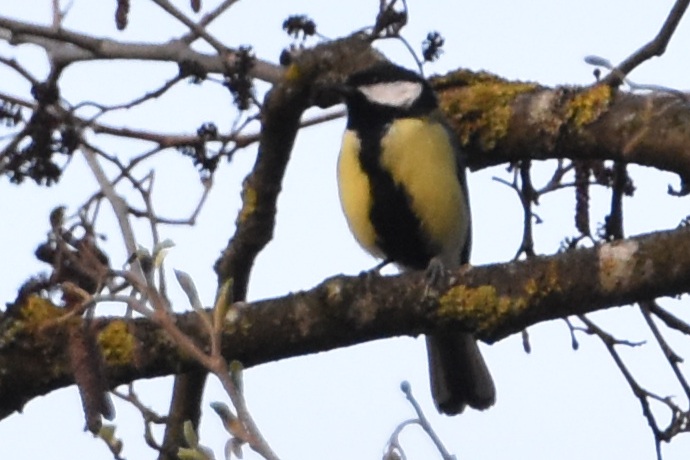
Kohlmeise auf ast. 2020-04-13 10.29.27 Luppmen
Zuerst beobachtet in 🇨🇭 an 2019-04-22.
Most common year-round bird at our house.
Often seen at the suet balls we hang out, or in fall at our sunflowers.
It's said that they will sound a false alarm at a feeding source, knowing that other birds listen for
their alarms and flee!
There are many entertaining stories in the Norwegian book 'The Secret Life of Small Birds'.
Ein Lieblingsbeutetier des Sperbers, wobei Katzen sicher mehr davon fressen.
They flit from tree to tree in small scattered groups,
and often avail themselves of the seeds on our sunflowers. They can be heard on the Luppman
in Fehraltorf at any time of year and day.
Etymologie: ![]() (Conrad) Gessner also notes that the coal tit was known as Kohlmeiß in German – the literal equivalent of its English name, though in its modern orthography Kohlmeise it refers to the great tit (Parus major). That bird was in Gessner's day usually called Spiegelmeiß ("multicoloured tit"[5]), Brandtmeiß ("burnt tit") or grosse Meiß ("great tit") in German. [Link]
(Conrad) Gessner also notes that the coal tit was known as Kohlmeiß in German – the literal equivalent of its English name, though in its modern orthography Kohlmeise it refers to the great tit (Parus major). That bird was in Gessner's day usually called Spiegelmeiß ("multicoloured tit"[5]), Brandtmeiß ("burnt tit") or grosse Meiß ("great tit") in German. [Link]
Verhalten: ![]() 'Studies in Europe on tits showed a 2-way doubly asymmetric interaction: the great tit (Parus major) is dominant over the blue tit (Cyanistes caeruleus)
during the nonbreeding season (Haftorn 1993), and the smaller blue tit is competitively dominant during the breeding season (Dhondt 1989).'
Another cited work notes that the coal tit is considered the bottom of the hierarchy in Scandinavia. [Interspecific dominance relationships and hybridization between black-capped and mountain chickadees | Behavioral Ecology]
'Studies in Europe on tits showed a 2-way doubly asymmetric interaction: the great tit (Parus major) is dominant over the blue tit (Cyanistes caeruleus)
during the nonbreeding season (Haftorn 1993), and the smaller blue tit is competitively dominant during the breeding season (Dhondt 1989).'
Another cited work notes that the coal tit is considered the bottom of the hierarchy in Scandinavia. [Interspecific dominance relationships and hybridization between black-capped and mountain chickadees | Behavioral Ecology]
![]() Like all tits it is a cavity nester, usually nesting in a hole in a tree. [Link]
Like all tits it is a cavity nester, usually nesting in a hole in a tree. [Link]
![]() Sie lernen voneinander und sogar von den verwandten Blaumeisen und finden neue Nahrungsquellen. Aber sie merken es sich auch, wenn sie sehen das andere Vögel etwas fressen, was ihnen nicht zukömmlich ist. [Schlaue Kohlmeisen gucken voneinander ab]
Sie lernen voneinander und sogar von den verwandten Blaumeisen und finden neue Nahrungsquellen. Aber sie merken es sich auch, wenn sie sehen das andere Vögel etwas fressen, was ihnen nicht zukömmlich ist. [Schlaue Kohlmeisen gucken voneinander ab]
Gesang: Nabu: Die erste Vogelart, die wir im Jahr hören, ist meistens die Kohlmeise mit ihrem typischen Läuten: "Zip Zäh" oder "Zip zip Zäh". [NABU Experte Lars Lachmann bei Deutschlandfunk Nova]
![]() Song highly variable, but usually consisting of two to three notes repeated in a motif. Same birds have many different motifs but generally repeat them many times before switching. Identified by its timbre and often metallic resonant quality, more than by actual phrasing (which is very variable). Often includes buzzing sounds in song. [Link]
Song highly variable, but usually consisting of two to three notes repeated in a motif. Same birds have many different motifs but generally repeat them many times before switching. Identified by its timbre and often metallic resonant quality, more than by actual phrasing (which is very variable). Often includes buzzing sounds in song. [Link]
Rufe: ![]() Generally more full-bodied and resonant calls than blue tit, and not so high-pitched. Characteristic Chaffinch-like "tink tink tink" often uttered by male. [Link]
Generally more full-bodied and resonant calls than blue tit, and not so high-pitched. Characteristic Chaffinch-like "tink tink tink" often uttered by male. [Link]
Körperlich: Länge=14 cm,
Flügelspanne=22-25 cm,
Gewicht=14-22 g
Habitate:
Siedlung
Gesang:
Said to have a repertoire as a species of 50 or more different songs, albeit simple ones, up to 10 per individual.
Females prefer a male with a large repertoire. One two-note song sounds like a squeaky bed.
Gesang Eigenschaften:
Melody: einfach rhythmisch (hmhmlmlmhmh), langsam, Frequency: medium (1-5 KHz) Singing season: 01-01 - 06-30 Dawn chorus start, 30 minutes before dawn.
♫ Ungewöhnlicher kohlmeise gesang hmhmlmlmhmh, approximately notes GCGCgCgCGCG. 2024-05-02 15.36.26 Fehraltorf (Gesang)
♫ Quelle: BirdNet
20200930_170429 birdnet 960 lhm glide saw great tit - Great tit - Fehraltorf.mp3
2020-09-30 17.04.29 Fehraltorf (Gesang)
♫ Kohlmeise llh, Gartenbaumläufer 5-noter zb at 22, 33, to id at 47 evtl sdrossel. ![]() Quelle: Zoom H6 2024-03-22 06.43.22 Staldenweiher (Gesang)
Quelle: Zoom H6 2024-03-22 06.43.22 Staldenweiher (Gesang)
♫ Kohlmeise lh 2-noter. ![]() Quelle: Zoom H6 2024-03-22 06.46.48 Staldenweiher (Gesang)
Quelle: Zoom H6 2024-03-22 06.46.48 Staldenweiher (Gesang)
♫ Quelle: BirdNet
20201030_072023 birdnet 1055 hlll - Great tit - Fehraltorf.mp3
2020-10-30 07.20.23 Fehraltorf (Gesang)
♫ Quelle: BirdNet
20200603_091437 birdnet 577 lmh kohlmeise - Great tit.mp3
2020-06-03 09.14.37 Hungerseeli (Gesang)
♫ 2024-04-27 09 40 kohlmeise mlh mlh etwa 5,5, 4,0, 7.5 MHz. 2024-04-27 09.40.00 Schachen, Tobel Wissbach till Degersheim (Gesang)
♫ Quelle: BirdNet
20201031_093140 birdnet 1067 lhlh wild guess great tit - No confident detection - Fehraltorf.mp3
2020-10-31 09.31.40 Fehraltorf (Gesang)
Ruf:
Chuck-a-chuck-a-chuck, sometimes preceded by higher 'wheat!'
Call from Xeno-Canto
♫ Call from Xeno-Canto Illustrates higher 'wheat' before the 'chuck-a-chuck' Quelle: XENOCANTO
XC586723 great tit call wheat chuck-a-chuck.mp3
(Ruf)
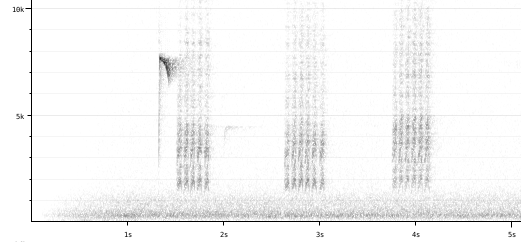 Call from Xeno-Canto
Call from Xeno-Canto
♫ Call from Xeno-Canto Quelle: XENOCANTO
XC592152 great tit call.mp3
(Ruf)

Ruf Eigenschaften:
Ruf Melodie: einfach rhythmisch, schnell, Frequenz: 1-7 KHz,
Haubenmeise / European crested tit (Lophophanes cristatus)
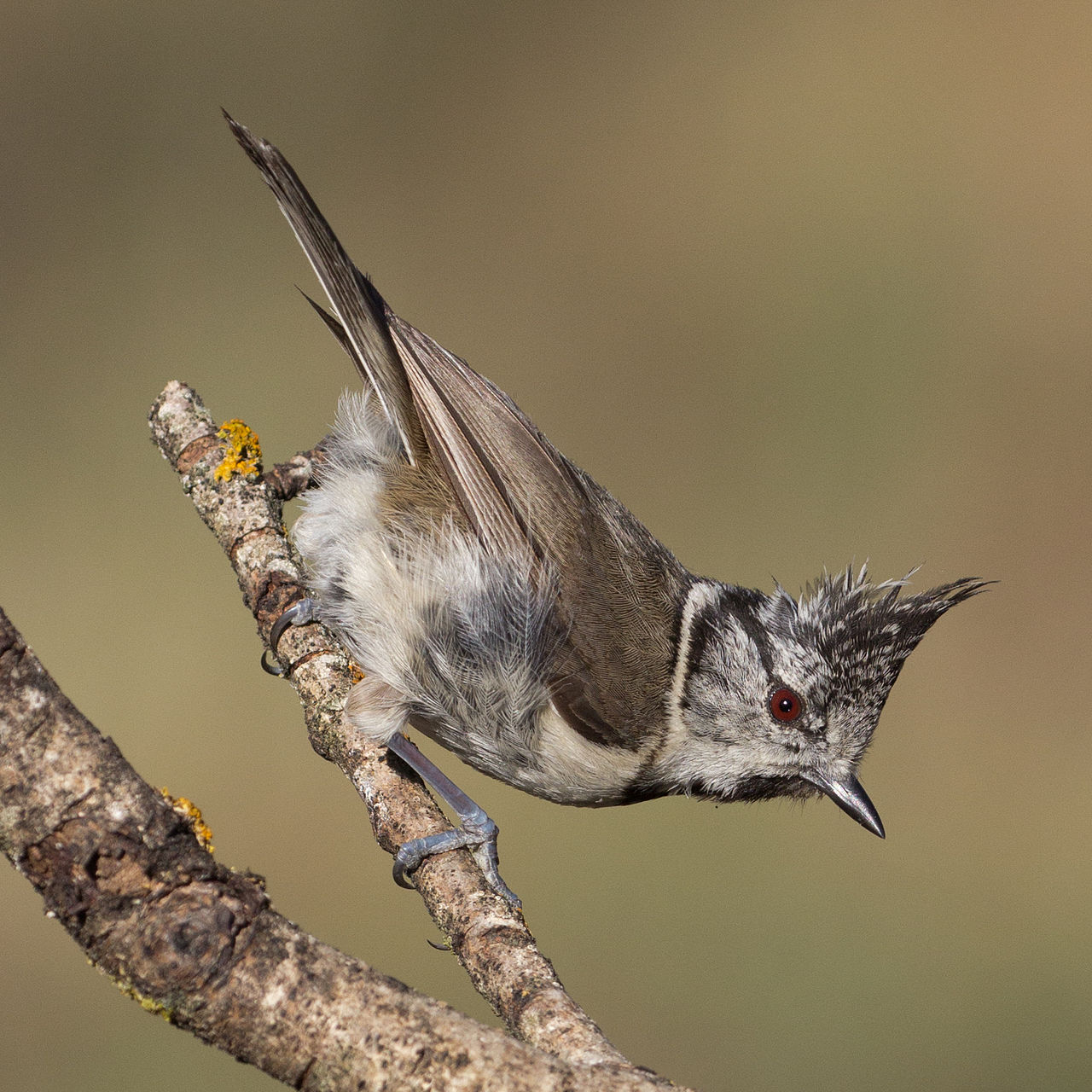
Wikipedia - Haubenmeise - Lophophanes cristatus - 01 - Carlos Delgado. Quelle: WIKIPEDIA
Wikipedia - Haubenmeise - Lophophanes_cristatus_-_01 - Carlos Delgado.jpg
Zuerst beobachtet in 🇨🇭 an 2020-07-31.
Allgemein: ![]() Die Haubenmeise (Lophophanes cristatus, Syn.: Parus cristatus; zu lateinisch crista ‚Kamm‘) ist eine Vogelart in der Familie der Meisen (Paridae). Diese Singvögel sind in Mitteleuropa ein weit verbreiteter und häufiger Brut- und Jahresvogel.
[more]
Die Haubenmeise (Lophophanes cristatus, Syn.: Parus cristatus; zu lateinisch crista ‚Kamm‘) ist eine Vogelart in der Familie der Meisen (Paridae). Diese Singvögel sind in Mitteleuropa ein weit verbreiteter und häufiger Brut- und Jahresvogel.
[more]
Gesang: ![]() Song: an improvisation over previously described calls. [Link]
Song: an improvisation over previously described calls. [Link]
Rufe: ![]() Call a characteristic vibrating rolling trill "Trrrrurrrurrrit", with last syllable emphasized and ending with ascending pitch. Often preceded by a couple of introductory "tzi tzi". [Link]
Call a characteristic vibrating rolling trill "Trrrrurrrurrrit", with last syllable emphasized and ending with ascending pitch. Often preceded by a couple of introductory "tzi tzi". [Link]
Körperlich: Länge=11 cm,
Flügelspanne=17-20 cm,
Gewicht=10-13 g
Habitate:
Wald
Gesang:
Higher-pitched than great tit - how distinguish from coal tit, etc?
Gesang Eigenschaften:
Melody: einfach rhythmisch, schnell, Frequency: high (3-9 KHz) Special sounds: lallen
Blaumeise / Eurasian blue tit (Cyanistes caeruleus)
Erste Blaumeise aufgenommen in Fehraltorf Ich hatte sie lange gehoert aber als Kohlmeise miserkannt (es ist oft aehnlich und ich war Anfaenger. Dann habe ich diesen auf einem Baum gesehen, und es wurde klar, dass sie wirklich auch bei uns leben. 2020-04-15 19.12.31 Luppmen
Zuerst beobachtet in 🇨🇭 an 2020-04-13.
Ich habe das erste mal eine Blaumeise bei uns daheim erkannt in April 2020, eine junge erst Juni 2020, und den Unterschied zwischen Jugendkleid und Schlicht/Prachtkleid erst in Juli 2021 kennengelertn.
In How to be a Bad Birdwatcher, Simon Barnes nicely explains hierarchies in feeding groups and how niches prevent blue tits from being starved by the larger, more dominant great tits. Normally they forage differently, he says, and at feeders it's simply clear to both that the great tit goes first. However in May 2021, we watched a blue tit repeatedly chase off a great tit that landed at the feeder where he was already enjoying some sunflower seeds! There are always exceptions to the rules!
Gesang: ![]() Song: Characteristic, clear, high-pitched, vibrating call. Usually introduced by a couple of accenting syllables, followed by ringing vibrating notes: "ti ti chuhuhuhuhuhuhuhuhuhu". [Link]
Song: Characteristic, clear, high-pitched, vibrating call. Usually introduced by a couple of accenting syllables, followed by ringing vibrating notes: "ti ti chuhuhuhuhuhuhuhuhuhu". [Link]
Rufe: ![]() Scolding alarm call: "tee-tee-tee-chirruwitt" similar to Great Tit. [Link]
Scolding alarm call: "tee-tee-tee-chirruwitt" similar to Great Tit. [Link]
Körperlich: Länge=11 cm,
Flügelspanne=17-20 cm,
Gewicht=9-12 g
Habitate:
Siedlung
Soziale Gruppen können bis 12 beinhalten.
Kann in sozialen Gruppen auch mit anderen Vögeln auftreten: : Kohlmeise.
Gesang:
General: High-pitched, often descending (hhll), occasionally ascending. "Christina compares it to a ping-pong ball dropping.
[In Januar singt die Kohlmeise als erster Vogel in Deutschland], dann kommt die Blaumeise dazu.
Gesang Eigenschaften:
Melody: einfach rhythmisch, langsam, Frequency: 3-9 KHz Special sounds: Triller Singing season: 01-01 - 06-30 Dawn chorus start, 35 minutes before dawn.
Ruf:
Low-high-high, with lightly raspy start, rather high.
Ruf Eigenschaften:
Ruf Melodie: einfach rhythmisch, langsam, Frequenz: high (3-9 KHz),
Sumpfmeise / Marsh tit (Poecile palustris)
Photographed on the Luppmen in September 2019 I didn't recognize it then but I'm pretty sure now. 2019-09-22 18.45.30 Luppmen
Zuerst beobachtet in 🇨🇭 an 2020-05-04.
I see them occasionally at the Luppmen or our house, but maybe 1% as often as Kohlmeisen and Blaumeisen.
BirdNet suggested a Wiesenmeise, but those are rare here and Sumpfmeisen not uncommon
according to BirdLife Zurich
Etymologie: ![]() Auch Nonnenmeise genannt - weil es auch eine Moenchmeise gibt? [Link]
Auch Nonnenmeise genannt - weil es auch eine Moenchmeise gibt? [Link]
Vokalisierung: ![]() Most easily identified by sound. Especially in areas where plumage is less distinct compared to Willow Tit, like in Britain. [Link]
Most easily identified by sound. Especially in areas where plumage is less distinct compared to Willow Tit, like in Britain. [Link]
Klapperlied - 6-8 Noten 'angeschlagen'
Gesang: ![]() Klapperlied. Reihe (6-8) weich angeschlagene Töne mittlerer Höhe. Ähnlich der Klappergrasmücke aber weicher. (Sumpf ist weich) Oft auch Rufe wie „psja“ zu hören. Ziemlich scharf u. gepresst. [Link]
Klapperlied. Reihe (6-8) weich angeschlagene Töne mittlerer Höhe. Ähnlich der Klappergrasmücke aber weicher. (Sumpf ist weich) Oft auch Rufe wie „psja“ zu hören. Ziemlich scharf u. gepresst. [Link]
Rufe: ![]() Most typical call an explosive, sneeze-like "pee-choo", starting high-pitched and ending on a lower note.
Most typical call an explosive, sneeze-like "pee-choo", starting high-pitched and ending on a lower note.
. [Link]
Körperlich: Länge=11 cm,
Flügelspanne=18-19 cm,
Gewicht=10-13 g
Habitate:
Wald
Gesang:
Higher-pitched than great tit, sometimes repetitive 1- and 2-note tunes like them, sometimes simple melodies, usually pure, sometimes chirpy or raspy. BirdID at Nord U says 'Song: A simple one or two note call repeated in series. Usually rising slightly in pitch, and with a "liquid" quality.'. At bird-song.ch it's hl-rest-hl, or 7-8 2-noter swoops. bird-song.ch names lh-break-hl as a pistjä call and also has a series of 7 or 8 falling 'swoops'.
Gesang Eigenschaften:
Melody: einfach rhythmisch (hhmmlll), schnell, Frequency: 2-10 KHz
♫ Quelle: XENOCANTO
XC727754 - Marsh Tit - Poecile palustris.mp3
(Gesang)

♫ Quelle: XENOCANTO
XC778730 - Marsh Tit - Poecile palustris - the two-note song BirdID, recorded in France.mp3
(Gesang)

Rufe:
1:
Falling note, relatively long, sometimes repeated - like the pee below without the choo?
Call from Xeno-Canto
♫ Call from Xeno-Canto Quelle: XENOCANTO
XC594764 marsh tit call.mp3
(Ruf)
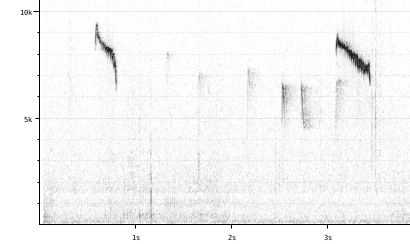 'Swooping' call on the Luppmen
'Swooping' call on the Luppmen
♫ 'Swooping' call on the Luppmen Chiffchaff calls go up, marsh tit calls down! Quelle: BirdNet
20201021_083851 birdnet 1019 am Luppmen - Marsh tit - Fehraltorf.mp3
2020-10-21 08.38.51 Luppmen (Ruf)
2:
BirdID (at Nord U.) says an explosive, sneeze-like "pee-choo",, similar to Blaumeise with clear note followed by rough ones, but hll
Call from Xeno-Canto
♫ Call from Xeno-Canto Quelle: XENOCANTO
XC733901 - Marsh Tit - Poecile palustris - pee-choo call, sometimes just pee - recorded in Germany.mp3
Deutschland (Ruf)

Ruf Eigenschaften:
Ruf Melodie: einnotig, langsam, Frequenz: 6-9 KHz, Spezielle Klänge: absteigend.
Bergmeise / Caspian tit (Poecile hyrcana)
Profil Wikipedia eBird Xeno-Canto
Allgemein: ![]() The Caspian tit (Poecile hyrcanus) is a passerine bird in the tit family. It breeds in the deciduous mountain forests of northern Iran, just extending into Azerbaijan.
[more]
The Caspian tit (Poecile hyrcanus) is a passerine bird in the tit family. It breeds in the deciduous mountain forests of northern Iran, just extending into Azerbaijan.
[more]
Singdrossel / Song thrush (Turdus philomelos)
Profil Wikipedia eBird Vogelwarte BirdLife ZH ornitho.ch bird-song.ch Xeno-Canto BirdID NABU
Singdrossel Isle de Brehat, Brittany. 2019-06-16 15.35.33 Île-de-Bréhat
Zuerst beobachtet in Brittany an 2019-06-16.
![]() Die Singdrossel (Turdus philomelos) ist eine Vogelart, die zur Familie der Drosseln (Turdidae) und zur Ordnung der Sperlingsvögel (Passeriformes) gehört. Sie ist in der gemäßigten und der borealen Zone der westlichen und zentralen Paläarktis beheimatet und zählt dort zu den häufigen waldbewohnenden Arten. Europäische Vögel überwintern im Mittelmeerraum. Im Südosten Australiens und in Neuseeland wurde sie Mitte des 19. Jahrhunderts als Neubürger (Neozoon) eingeführt.
[more]
Die Singdrossel (Turdus philomelos) ist eine Vogelart, die zur Familie der Drosseln (Turdidae) und zur Ordnung der Sperlingsvögel (Passeriformes) gehört. Sie ist in der gemäßigten und der borealen Zone der westlichen und zentralen Paläarktis beheimatet und zählt dort zu den häufigen waldbewohnenden Arten. Europäische Vögel überwintern im Mittelmeerraum. Im Südosten Australiens und in Neuseeland wurde sie Mitte des 19. Jahrhunderts als Neubürger (Neozoon) eingeführt.
[more]
Vokalisierung: ![]() Very melodious, varied and a master imitator. Still easily distinguished by its tendency to repeat introductory motives two or more times, and its many high pitched themes. Each phrase is loud and penetrating and the tempo deliberate. [Link]
Very melodious, varied and a master imitator. Still easily distinguished by its tendency to repeat introductory motives two or more times, and its many high pitched themes. Each phrase is loud and penetrating and the tempo deliberate. [Link]
Gesang: ![]() Klangfarbe ähnlich obiger Art [Amsel], aber jedes Element 2-4mal wiederholt, Pausen zwischen den Phrasen.(klingt oft wie „Philipp“, oder „Judith“) Einzige Drossel unseres Gebietes die diese Wiederholungen macht. Singt oft nicht von Baumspitze aus, sondern aus dem Geäst.
[Link]
Klangfarbe ähnlich obiger Art [Amsel], aber jedes Element 2-4mal wiederholt, Pausen zwischen den Phrasen.(klingt oft wie „Philipp“, oder „Judith“) Einzige Drossel unseres Gebietes die diese Wiederholungen macht. Singt oft nicht von Baumspitze aus, sondern aus dem Geäst.
[Link]
Rufe: ![]() Rufe :“zipp“, oft beim abfliegen.
[Link]
Rufe :“zipp“, oft beim abfliegen.
[Link]
![]() Most heard (but easily overlooked) contact call is a dry and very short "zip", sometimes given as a two syllable call "zip-ip". [Link]
Most heard (but easily overlooked) contact call is a dry and very short "zip", sometimes given as a two syllable call "zip-ip". [Link]
Körperlich: Länge=23 cm,
Flügelspanne=33-36 cm,
Gewicht=65-100 g
Habitate:
Wald
Gesang:
Paced like a blackbird, humorous mix of elements like a nightingale. Huge range, elements from 2-5 KHz, others 6.5-9 KHz. Can sing for up to 50 minutes, and a male may know 100 melodies in its repertoire.
Gesang Eigenschaften:
Melody: improvisiert melodisch, langsam, Frequency: 2-9 KHz Special sounds: absteigend Singing season: 02-01 - 07-31 Dawn chorus start, 60 minutes before dawn.
Ruf:
One or two high chirps followed by long pause of 1-2 seconds
Ruf Eigenschaften:
Kontaktruf Ruf Melodie: einnotig, langsam, Frequenz: 7-10 KHz,
Misteldrossel / Mistle thrush (Turdus viscivorus)
Profil Wikipedia eBird Vogelwarte BirdLife ZH ornitho.ch bird-song.ch Xeno-Canto BirdID NABU
Misteldrossel. 2020-05-07 12.56.02 Hungerseeli
Zuerst beobachtet in 🇨🇭 an 2020-05-07.
After a long outing in the woods with no 'new' discoveries where I hoped there might be,
I followed a woodpecker-like rattle deep into the woods,
and eventually managed a clear view of a mistle thrush (German Misteldrossel)
while standing directly under the tree where I heard it.
I believe it was a pair, but I only got a picture of one.
The breast has that checkerboard look that thrushes have.
I initially saw them in the woods but later by Neschwil they came
out of the woods into the fields to feed.
Gesang: ![]() Gesang ähnlich dem der Amsel, aber weniger abwechslungsreich und melancholisch, fast weinerlich klingend. Meist von Tannenspitze aus.
[Link]
Gesang ähnlich dem der Amsel, aber weniger abwechslungsreich und melancholisch, fast weinerlich klingend. Meist von Tannenspitze aus.
[Link]
![]() Song loud, far reaching and melodic. Most similar to Blackbird, but pitch is higher, phrases shorter (3-6 notes) and most notably, pauses between phrases are much shorter. All which gives the song a much more hurried feel than that of the Blackbird. Timbre is thinner and slightly shivering, and tonal range more limited. May have recurring favourite motifs, but does not repeat phrases like Song Thrush. Sometimes adds higher pitched parts and imitations. [Link]
Song loud, far reaching and melodic. Most similar to Blackbird, but pitch is higher, phrases shorter (3-6 notes) and most notably, pauses between phrases are much shorter. All which gives the song a much more hurried feel than that of the Blackbird. Timbre is thinner and slightly shivering, and tonal range more limited. May have recurring favourite motifs, but does not repeat phrases like Song Thrush. Sometimes adds higher pitched parts and imitations. [Link]
Rufe: ![]() Rufe:schnarrend „kerr“, daneben „tück-tück-tück“
[Link]
Rufe:schnarrend „kerr“, daneben „tück-tück-tück“
[Link]
![]() Other calls; a dry rattle, likened to the sound of a piece of wood drawn over a coarse comb, and a Fieldfare-like "chuck". [Link]
Other calls; a dry rattle, likened to the sound of a piece of wood drawn over a coarse comb, and a Fieldfare-like "chuck". [Link]
Körperlich: Länge=27 cm,
Flügelspanne=42-47 cm,
Gewicht=100-150 g
Habitate:
Wald
Sieht ähnlich aus wie:
Wiesenpieper.
Gesang:
Song: ![]() Gesang ähnlich Amsel, aber eintöniger mit geringerem Tonumfang [auch kürzer, kein schnirpsliges Ende -- Bill] [Link]
Gesang ähnlich Amsel, aber eintöniger mit geringerem Tonumfang [auch kürzer, kein schnirpsliges Ende -- Bill] [Link]
Gesang Eigenschaften:
Melody: nicht musikalisch, schnell, Frequency: 2-9 KHz Special sounds: rasseln
Ruf:
General: I mistook this one for a woodpecker the first time I heard it,
partly because BirdNet also did!
Rattle generated in vocal tract, not with the beak!
Ruf Eigenschaften:
Ruf Melodie: nicht musikalisch, schnell, Frequenz: 2-9 KHz, Spezielle Klänge: rasseln.
Wacholderdrossel / Fieldfare (Turdus pilaris)
Profil Wikipedia eBird Vogelwarte BirdLife ZH ornitho.ch bird-song.ch Xeno-Canto BirdID NABU
Wacholderdrossel am Luppmen in Fehraltorf 2021-01-16 14.28.10
Zuerst beobachtet in 🇨🇭 an 2021-01-16.
Ich hatte eine interessantes Erlebnis mit Wacholderdrosseln - es ist unter Rotdrossel beschrieben.
Aussehen und Identifizierung: ![]() Die Wacholderdrossel ist mit einer Körperlänge von 22 bis 27 cm nur wenig kleiner als die bekanntere Amsel, jedoch etwas langflügeliger als diese und deutlich schwerer. [Link]
Die Wacholderdrossel ist mit einer Körperlänge von 22 bis 27 cm nur wenig kleiner als die bekanntere Amsel, jedoch etwas langflügeliger als diese und deutlich schwerer. [Link]
Geographie: Nabu: 'Die ursprüngliche Heimat dieser nordischen Drossel ist die Sibirische Taiga.
Vor etwa 200 Jahren begann ihre Ausbreitung in den südwestlichen Raum Europas.'Wie der Misteldrossel vertreibt der Wacholderdrossel Feinde wie Elster, Rabenkrähe oder Bussard
vom Nestgebiet mit Kotbomben. ['Die Wacholderdrossel - Turdus pilaris
Ein Wintergast wird heimisch', von Paul Laakmann aus Buntspecht 3/1986]
Verhalten: ![]() Misteldrossel greifen Vögel an die ihr Nest bedrohen koennten.
Das nennt man eine Kopropolemische Reaktion - vom griechischen für Kot under Krieg.
Mester meint Hauptziel der Angriffe waere meistens der Kopf.
Woanders wurde erwahnt, dass der Kot der Misteldrosseln besonders klebrig ist,
eben weil der Vogel viele Mistelbeeren frisst, und wenn die Feder zusammenkleben,
koennt das Opfer nicht optimal fliegen. [Artikel 'Defensive Defaekation in der Vogelwelt' von Horst Mester, erschienen Oktober 1976 in 'Der Ornithologische Beobachter']
Misteldrossel greifen Vögel an die ihr Nest bedrohen koennten.
Das nennt man eine Kopropolemische Reaktion - vom griechischen für Kot under Krieg.
Mester meint Hauptziel der Angriffe waere meistens der Kopf.
Woanders wurde erwahnt, dass der Kot der Misteldrosseln besonders klebrig ist,
eben weil der Vogel viele Mistelbeeren frisst, und wenn die Feder zusammenkleben,
koennt das Opfer nicht optimal fliegen. [Artikel 'Defensive Defaekation in der Vogelwelt' von Horst Mester, erschienen Oktober 1976 in 'Der Ornithologische Beobachter']
Vokalisierung: ![]() Very vocal. [Link]
Very vocal. [Link]
Gesang: ![]() Gesang nicht melodisch,aus gepressten, quietschenden Tönen bestehend, fast nur im Flug vorgetragen.
[Link]
Gesang nicht melodisch,aus gepressten, quietschenden Tönen bestehend, fast nur im Flug vorgetragen.
[Link]
![]() Song a mix of dry contact calls; "trrrt trrrrt", and high pitched, drawn out, chattering improvisations. [Link]
Song a mix of dry contact calls; "trrrt trrrrt", and high pitched, drawn out, chattering improvisations. [Link]
Rufe: ![]() Schackernd, ähnlich obiger Art [Misteldrossel], aber weicher. Am Brutplatz raue krächzende Rufe.
[Link]
Schackernd, ähnlich obiger Art [Misteldrossel], aber weicher. Am Brutplatz raue krächzende Rufe.
[Link]
![]() Scolding call a hard "check", often given in decelerating series. Contact call in migration a soft, pleasant but, buzzy "weet". Typically bursts into continuos, squeaky chattering at takeoff. [Link]
Scolding call a hard "check", often given in decelerating series. Contact call in migration a soft, pleasant but, buzzy "weet". Typically bursts into continuos, squeaky chattering at takeoff. [Link]
Körperlich: Länge=25 cm,
Flügelspanne=39-42 cm,
Gewicht=80-120 g
Habitate:
Wald
Gesang:
BirdID says song a mix of dry contact calls, BirdLife that it's almost only heard in flight. The XC recording is a bit of a chuckle to me.
Gesang Eigenschaften:
Melody: nicht musikalisch, langsam, Frequency: 1-6 KHz Special sounds: Raspel
♫ Quelle: XENOCANTO
XC769296 - Fieldfare - Turdus pilaris - song, a series of contactcalls.mp3
(Gesang)

Rotdrossel / Redwing (Turdus iliacus)
Profil Wikipedia eBird Vogelwarte BirdLife ZH ornitho.ch bird-song.ch Xeno-Canto BirdID NABU
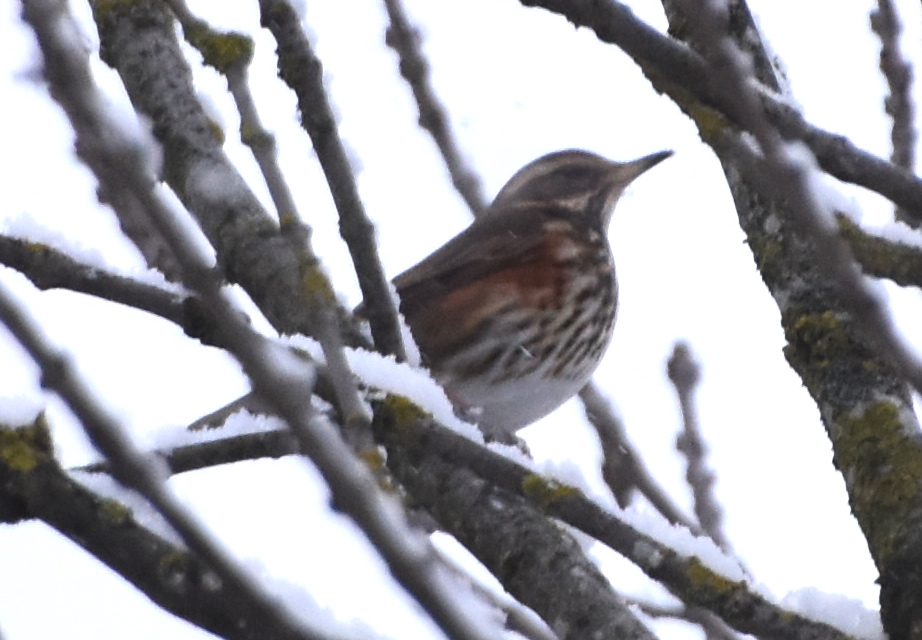
Rotdrossel in einem baum neben dem Luppmen, rot unter den Fluegeln gut erkennbar, auch weisser Ueberaugenstreif. 2020-12-30 10.33.36 Luppmen
Zuerst beobachtet in Iceland an 2015-06-05.
In der Schweiz nur als Durchzügler und Wintergast zu sehen, da sie in Skandinavien daheim sind.
Ich habe eine Gruppe gesehen, die in einem Baum neben dem Luppmen gelandet ist.
Die einen haben einen komischen Gesang von sich gegeben, den ich leider nicht aufnehmen konnte.
Die sind etwas nervös gewesen und schnell weiter davon geflogen.
I had an interesting educational experience with fieldfares!
At the end of December 2020 I saw redwings in Fehraltorf for the first time.
They're a winter guest that breeds in Scandinavia.
Jan 2021 I saw one from our dining room window, and two days later
saw 31 of them land in four trees along the Luppmen brook,
and spontaneously decided to report them via the eBird app.
The next day I got an automated response saying this was an unusually high number,
and that I should document the sighting further. I added pictures of the group in the trees
pus one of an individual close up. Then I got a nice e-mail from eBird volunteer Raphaël Nussbaumer,
an Earth Science PhD and postdoc at the Swiss Ornithological Institute, saying that my redwings were fieldfares.
I checked the guide books and apps, and that seemed plausible. I was surprised that none of them mentioned the danger
of confusing the two, which are actually quite similar (and related). I checked the closeup I took on December 31
and asked Raphaël if it was actually a redwing, and he confirmed it. So I actually found two (to me) new thrushes
within 3 weeks. He noted 'they are often found mixed with fieldfare or mistle thrush, so one has to be careful to check the entire group and not assume that all are redwings.
I saw 8 similar looking birds when I saw the actual redwing, and while I think there's more than one redwing there,
I can't see the whole flock well enough to be sure.
Aussehen und Identifizierung: ![]() Vogelwarte beschreibt genau was ich gesehen habe: 'etwas kleiner als die Singdrossel und von dieser durch den auffallenden weissen Überaugenstreif und die rostroten Unterflügeldecken zu unterscheiden; beide Geschlechter gleich.' [Link]
Vogelwarte beschreibt genau was ich gesehen habe: 'etwas kleiner als die Singdrossel und von dieser durch den auffallenden weissen Überaugenstreif und die rostroten Unterflügeldecken zu unterscheiden; beide Geschlechter gleich.' [Link]
Vokalisierung: ![]() First a simple, melodic phrase of 3 - 6 notes, usually followed by a more silent, indistinct, fast and less melodic, chattering sequence. First part highly variable from place to place, but constant in individuals. Often causes confusion when a new dialect is heard at a distance, since only the first part is far-reaching, and the diagnostic two-part structure gets lost. [Link]
First a simple, melodic phrase of 3 - 6 notes, usually followed by a more silent, indistinct, fast and less melodic, chattering sequence. First part highly variable from place to place, but constant in individuals. Often causes confusion when a new dialect is heard at a distance, since only the first part is far-reaching, and the diagnostic two-part structure gets lost. [Link]
Gesang: ![]() Song delivered in two parts. [Link]
Song delivered in two parts. [Link]
Rufe: ![]() Contact call a thin, drawn and sharp "sreee". Often heard at night during migration. Alarm call harder, dryer and more raucous than other thrushes. [Link]
Contact call a thin, drawn and sharp "sreee". Often heard at night during migration. Alarm call harder, dryer and more raucous than other thrushes. [Link]
Körperlich: Länge=21 cm,
Flügelspanne=33-34 cm,
Gewicht=50-75 g
Habitate:
Wald
Gesang:
![]() Song delivered in two parts. First a simple, melodic phrase of 3 - 6 notes, usually followed by a more silent, indistinct, fast and less melodic, chattering sequence. First part highly variable from place to place, but constant in individuals. [Link]
Song delivered in two parts. First a simple, melodic phrase of 3 - 6 notes, usually followed by a more silent, indistinct, fast and less melodic, chattering sequence. First part highly variable from place to place, but constant in individuals. [Link]
Gesang Eigenschaften:
Eselsbrücke down 6+chattering Melody: stereotypisch melodisch, langsam, Frequency: 3-5 KHz
♫ Quelle: XENOCANTO
XC320315 - Redwing - Turdus iliacus.mp3
(Gesang)

Rotkehlchen / European robin (Erithacus rubecula)
Profil Wikipedia eBird Vogelwarte BirdLife ZH ornitho.ch bird-song.ch Xeno-Canto BirdID NABU
Rotkehlchen. 2020-04-02 09.39.00 Luppmen
Zuerst beobachtet in 🇨🇭 an 2020-04-02.
Rotes Geschicht und rote Brust, Bauch hell, Flügel und Rücken braun und grau.
Im Baum singend, oder auf dem Boden auf der Suche nach Futter.
Gesang: ![]() Song medium to very high pitched, with mostly clear tones with a liquid quality. Timbre reminiscent of Wren or Dunnock, but with a much more varied structure and tempo. Pitch ranges from very high to low, almost thrush-like, notes. No recognizable motifs. Often ends on a rising or falling pitch, giving it a "Chinese" accent. [Link]
Song medium to very high pitched, with mostly clear tones with a liquid quality. Timbre reminiscent of Wren or Dunnock, but with a much more varied structure and tempo. Pitch ranges from very high to low, almost thrush-like, notes. No recognizable motifs. Often ends on a rising or falling pitch, giving it a "Chinese" accent. [Link]
Rufe: ![]() Alarm call a thin, electric "tick", often in series with decelerating tempo. [Link]
Alarm call a thin, electric "tick", often in series with decelerating tempo. [Link]
Körperlich: Länge=14 cm,
Flügelspanne=20-22 cm,
Gewicht=14-21 g
Habitate:
Wald
Gesang:
General: Hoch aber auch bis tief, z.B. 2.9-7.7 KHz.
Wikipedia sagt, 'Der Gesang des Rotkehlchens ist mit 275 nachgewiesenen,
sich fortlaufend ändernden Motiven äußerst variabel.
[Ein einzelner Vogel lernt teilweise mehr als 30 verschiedene Strophen, sagteChristina Ebneter in BirdLife Feldornithologie-Kurs.]
Er wird mit vorgestreckter, das Rot betonender Brust, in der Regel von einer hohen Singwarte aus, vorgetragen. Er beginnt etwa eine Stunde vor Sonnenaufgang und ist noch eine gute Zeit nach Sonnenuntergang zu hören, hauptsächlich jedoch während der Dämmerung.
Der Revieranzeigegesang wird normalerweise mit perlenden reinen Tönen und Trillern eingeleitet und fällt gegen Ende langsam ab; hohe metallische Töne werden oft dazwischen eingeschoben. Häufig sind in die 2,5 Sekunden langen Strophen auch undeutliche Imitationsphrasen eingelegt. Auf den Menschen wirkt der Reviergesang lieblich und schwermütig melodiös. Ist das Rotkehlchen hochgradig erregt, verdeutlicht es seinen Willen zur Eskalation durch übertönendes oder störendes Singen.'
Ich habe in Ticino und Falera festgestellt, dass die Rotkehlchen immer noch singen und habe es nachher auch daheim
im Zürcher Oberland gehört; das Ende des Singen Ende Juli ist anscheinend relativ.
Seitdem weiss ich dass es eine der wenigen Vogelarten ist, die auch in Winter
ein Territorium verteidigt...darum.
Song: ![]() Only for a short period in late summer while they are moulting and inconspicuous do robins stop singing. Both sexes sing. [RSPB article]
Only for a short period in late summer while they are moulting and inconspicuous do robins stop singing. Both sexes sing. [RSPB article]
Gesang Eigenschaften:
Melody: improvisiert melodisch, schnell, Frequency: high (3-9 KHz) Special sounds: flöten Singing season: 02-01 - 07-31 Only pauses singing while molting and thus endangered. Dawn chorus start, 50 minutes before dawn.
Rufe:
1:
"ticking call", "tik", "tek", .
Personal: A single note usually repeated twice. Somewhat sputtery. BirdID refers to 'a thin, electric "tick". In one source said to be used as alarm call.
Call: ![]() A variety of calls is also made at any time of year, including a ticking note indicating anxiety or mild alarm. [Link]
A variety of calls is also made at any time of year, including a ticking note indicating anxiety or mild alarm. [Link]
I heard 3 or 4 scattered birds calling it in woods with underbrush but saw no birds. BirdNet told me they were robins, which I found hard to believe, but on comparing it with recordings at XenoCanto, I was convinced! Maybe they were telling each other "Don't show yourself to that alarming guy!".
♫ I heard 3 or 4 scattered birds calling it in woods with underbrush but saw no birds. BirdNet told me they were robins, which I found hard to believe, but on comparing it with recordings at XenoCanto, I was convinced! Maybe they were telling each other "Don't show yourself to that alarming guy!". 2021-07-03 08.05.14 (Ruf)
2:
"srii".
Low chirpy to sputtery monotone
Xeno-Canto recording by Stanislas Wroza noted as 'srii' call
♫ Xeno-Canto recording by Stanislas Wroza noted as 'srii' call Quelle: XENOCANTO
XC496627 European robin srii call.mp3
(Ruf)
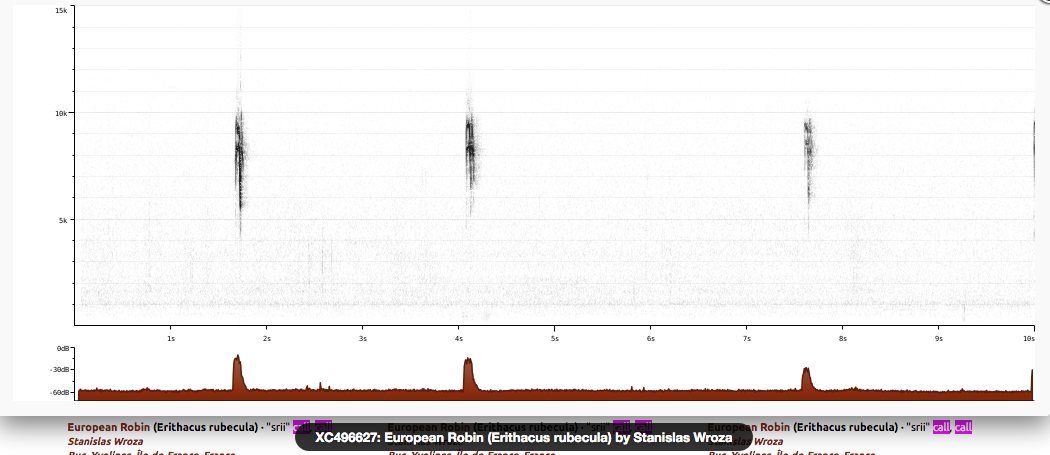
3:
"tsii".
General: A longer falling note (9Khz-7Khz) called a tsii by the recordist.
Call: ![]() Sound Approach: If you listen carefully you may notice that in the daytime, apart from the ubiquitous tik call, Robins also give a shrill tsi rather frequently. It is this tsi that they adapt for use as a nocturnal flight call. Nfc=night flight call. [Link]
Sound Approach: If you listen carefully you may notice that in the daytime, apart from the ubiquitous tik call, Robins also give a shrill tsi rather frequently. It is this tsi that they adapt for use as a nocturnal flight call. Nfc=night flight call. [Link]
In the sonogram it's a longer, falling note.
♫ In the sonogram it's a longer, falling note. Quelle: XENOCANTO
XC512416 - European Robin - Erithacus rubecula - named tsii or alarm call by recordist Marcin Solowiej in Poland.mp3
(Ruf)
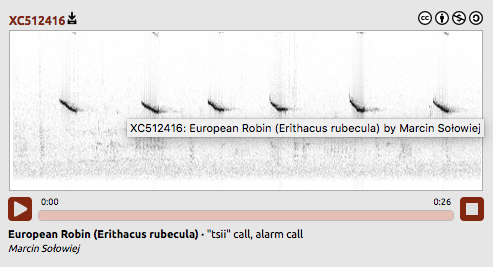
4:
Here is an audio of a high-pitched hawk call (7.5-8.5 KHz). See also a YouTube video comparing ground threats from aerial threats.
♫ Quelle: XENOCANTO
XC139085 - European Robin - Erithacus rubecula - hawk alarm call from Paul Driver.mp3
(Alarmruf)
Ruf Eigenschaften:
Ruf Melodie: einnotig, langsam, Frequenz: 4-9 KHz, Spezielle Klänge: stottern/kieseln.
Trauerschnäpper / European pied flycatcher (Ficedula hypoleuca)
Profil Wikipedia eBird Vogelwarte BirdLife ZH ornitho.ch bird-song.ch Xeno-Canto BirdID NABU
Trauerschnaepper. 2021-05-04 09.33.06 Flachsee am Reuss
Zuerst beobachtet in 🇨🇭 an 2020-04-15.
Aussehen und Identifizierung: ![]() Kleiner SW Vogel, Kopf schwarz mit weissem Punkt an der Stirn, Bauch weiss. Gesang gar nicht traurig! [Link]
Kleiner SW Vogel, Kopf schwarz mit weissem Punkt an der Stirn, Bauch weiss. Gesang gar nicht traurig! [Link]
Gesang: ![]() Song a pleasant, tuneful, simple but varied phrase. [Link]
Song a pleasant, tuneful, simple but varied phrase. [Link]
Rufe: ![]() Alarm call a sharp, energetic "wit", often in combination with a short "tic"; "whit-tic". Typically starts with disyllabic notes being repeated 3-5 times, diminishing in pitch and intensity like an echo of the first two syllables. Occasionally throws in a quick diagnostic ascending scale excercise. Clear notes and well defined pauses between phrases. [Link]
Alarm call a sharp, energetic "wit", often in combination with a short "tic"; "whit-tic". Typically starts with disyllabic notes being repeated 3-5 times, diminishing in pitch and intensity like an echo of the first two syllables. Occasionally throws in a quick diagnostic ascending scale excercise. Clear notes and well defined pauses between phrases. [Link]
Körperlich: Länge=13 cm,
Flügelspanne=21-24 cm,
Gewicht=10-15 g
Habitate:
Wald
Gesang:
Nice short melody, often with 2-note parts. Blackbird-like but little variation (though differs in dialect).
Gesang Eigenschaften:
Eselsbrücke Schwarzer Kopf aber nicht traurig Melody: stereotypisch melodisch, schnell, Frequency: 3-10 KHz
♫ Quelle: XENOCANTO
XC723965 - European Pied Flycatcher - Ficedula hypoleuca - song.mp3
(Gesang)

Halsbandschnäpper / Collared flycatcher (Ficedula albicollis)
Profil Wikipedia eBird Vogelwarte BirdLife ZH ornitho.ch Xeno-Canto NABU
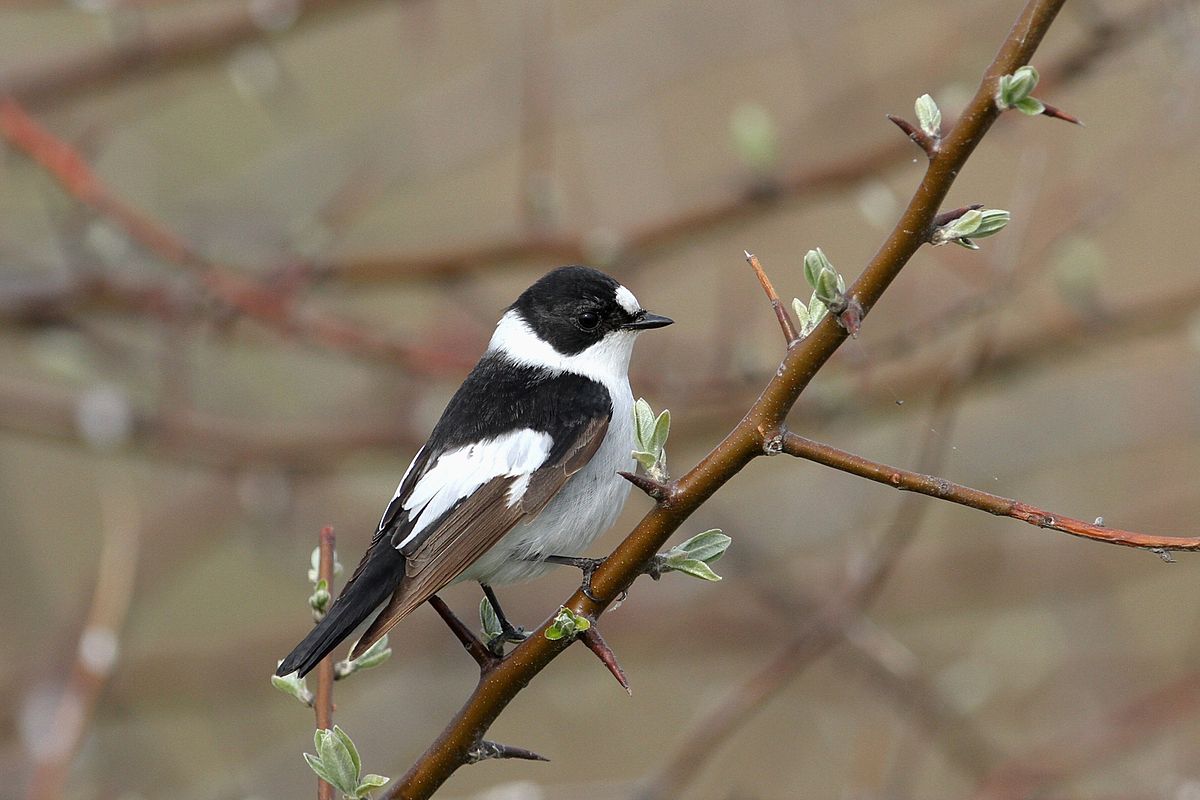
Wikipedia: Collared flycatcher Quelle: OTHER
1200px-Collared_flycatcher_%28Ficedula_albicollis%29.jpg
Allgemein: ![]() Der Halsbandschnäpper (Ficedula albicollis) ist eine Vogelart aus der Familie der Fliegenschnäpper. Er ist ein Charaktervogel insbesondere der Streuobstwiesen.
[more]
Der Halsbandschnäpper (Ficedula albicollis) ist eine Vogelart aus der Familie der Fliegenschnäpper. Er ist ein Charaktervogel insbesondere der Streuobstwiesen.
[more]
Habitate:
Wald
Gesang:
Simple tune...
Gesang Eigenschaften:
Eselsbrücke Mein Halsband, mein Halsband, er schnäppt Melody: stereotypisch melodisch, schnell, Frequency: 3-7 KHz
♫ Quelle: XENOCANTO
XC727811 - Collared Flycatcher - Ficedula albicollis - song, recorded in Croatia.mp3
(Gesang)

♫ Quelle: XENOCANTO
XC727811 - Collared Flycatcher - Ficedula albicollis - song is variable, this improvises on a 4-note theme.mp3
(Gesang)

Kleiber / European nuthatch (Sitta europaea)
Kleiber schwaendi. 2020-04-04 15.28.00 Luppmen
Zuerst beobachtet in 🇨🇭 an 2020-04-04.
Maybe 8 or 10 short loud notes, a bit of a whoop on the sonogram
Vokalisierung: Other: Eurasian Nuthatch is very vocal. [Link]
![]() Very varied voice. [Link]
Very varied voice. [Link]
Gesang: Other: The song is very variable, with rising and falling notes, sometimes with repetition of excitement calls. [Link]
![]() The song is a slow whistled pee-pee-pee with many variants, including a faster version, and may be intermingled with the call. [Link]
The song is a slow whistled pee-pee-pee with many variants, including a faster version, and may be intermingled with the call. [Link]
Other: Song a simple series of loud notes. [Link]
![]() Song a simple series of loud notes. [Link]
Song a simple series of loud notes. [Link]
Rufe: Other: It gives loud calls when excited, an abrupt ‘twit”, only one, or in slow series, but often in phrases of 3-4 notes in rapid succession. But in great excitement, it utters phrases of about ten notes per second!
We can also hear some shrill “sirrrr”, becoming harsher in alarm call. The contact call is a thin “tsit” uttered before to take off.
[Link]
![]() The Eurasian nuthatch calls frequently, usually with a loud, sharp dwip normally repeated twice, sometimes more often if excited. It has a shrill sirrrr or tsi-si-si alarm call, and a thin tsit pre-flight call. [Link]
The Eurasian nuthatch calls frequently, usually with a loud, sharp dwip normally repeated twice, sometimes more often if excited. It has a shrill sirrrr or tsi-si-si alarm call, and a thin tsit pre-flight call. [Link]
Other: Very varied voice. Ranging from very high pitched whistles and melodic resonant calls, to chattering and nasal mocking sounds. Characteristic warning call a hard "check" or "chwit", often in rapid series, like a pebble bouncing on hollow ice. [Link]
![]() Ranging from very high pitched whistles and melodic resonant calls, to chattering and nasal mocking sounds. Characteristic warning call a hard "check" or "chwit", often in rapid series, like a pebble bouncing on hollow ice. [Link]
Ranging from very high pitched whistles and melodic resonant calls, to chattering and nasal mocking sounds. Characteristic warning call a hard "check" or "chwit", often in rapid series, like a pebble bouncing on hollow ice. [Link]
Körperlich: Länge=14 cm,
Flügelspanne=22-27 cm,
Gewicht=21-26 g
Habitate:
Wald
Gesang:
Song: ![]() Song a simple series of loud notes [Link]
Song a simple series of loud notes [Link]
Gesang Eigenschaften:
Melody: einnotig (ll), schnell, Frequency: medium (1-5 KHz) Singing season: 02-01 - 07-31 Dawn chorus start, 10 minutes before dawn.
♫ Is the brevity what makes it a song, whereas calls seem to go on endlessly? Quelle: XENOCANTO
XC777051 - Eurasian Nuthatch - Sitta europaea, recorded in France and designated as song - a series of 5-6 whoops, pause and repeat, hard for me to distinguish from a ca-ll.mp3
(Gesang)
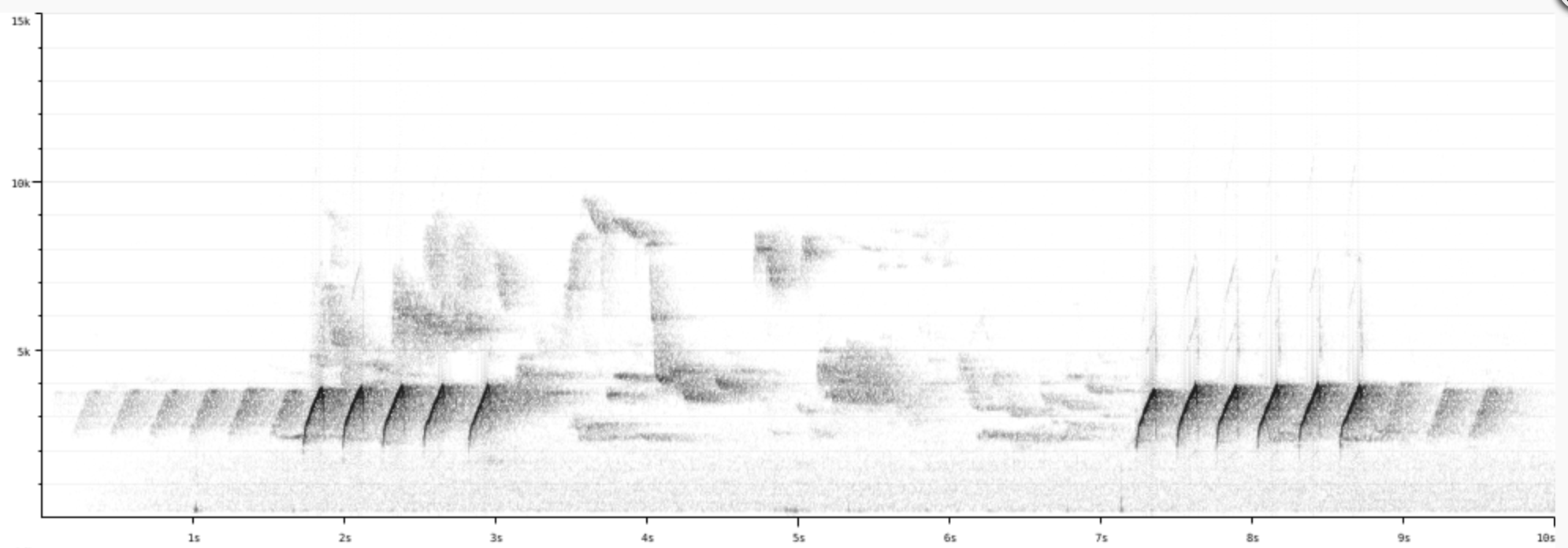
Rufe:
1:
Twit, dwip.
Schnelle Sequenz - ist es der oben erwaehnte 'twit'?
Long fast sequence of identical whoops, possibly 'twit' call.
♫ Long fast sequence of identical whoops, possibly 'twit' call. Quelle: XENOCANTO
XC129686 - Eurasian Nuthatch - Sitta europaea caesia.mp3
(Ruf)
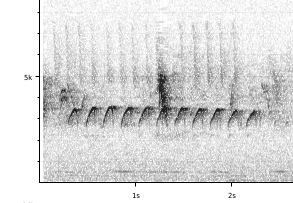 Similar to XC423335 but very regular rhythm
Similar to XC423335 but very regular rhythm
♫ Similar to XC423335 but very regular rhythm Quelle: XENOCANTO
XC781193 - Eurasian Nuthatch - Sitta europaea - call, one note, regular rhythm, 2 per second, recorded in Spain.mp3
Spanien (Ruf)
 One note, irregular rhythm. A bird calling while moving up a pine tree (says recordist Nick Talbot).
One note, irregular rhythm. A bird calling while moving up a pine tree (says recordist Nick Talbot).
♫ One note, irregular rhythm. A bird calling while moving up a pine tree (says recordist Nick Talbot). Quelle: XENOCANTO
XC423335 - Eurasian Nuthatch - Sitta europaea caesia.mp3
(Ruf)

2:
Kleiber whoop Ruf ist aehnlich wie der vom Buchfink.
Er wiederholt ihn etwa viermal.
3:
Tsit.
Recordist Stanislav Wroz says flight call.
Flight call in Dampierre-en-Yvelines, Yvelines, Île-de-France. Wikipedia describes a 'thin tsit pre-flight call'.
♫ Flight call in Dampierre-en-Yvelines, Yvelines, Île-de-France. Wikipedia describes a 'thin tsit pre-flight call'. Quelle: XENOCANTO
XC522601 - Eurasian Nuthatch - Sitta europaea.mp3
(Flugruf)
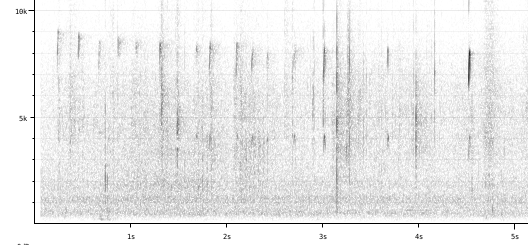
Ruf Eigenschaften:
Ruf Melodie: einnotig, schnell, Frequenz: 2-3 KHz,
Eurasian Wren foraging in the reeds at the frozen Lake Pfaeffikon 2021-02-15 08.41.30 Pfäffikersee
Zuerst beobachtet in 🇨🇭 an 2019-07-07.
Etymologie: ![]() The scientific name is taken from the Greek word "troglodytes" (from trogle a hole, and dyein to creep), meaning "cave-dweller",[4] and refers to its habit of disappearing into cavities or crevices whilst hunting arthropods or to roost. [Link]
The scientific name is taken from the Greek word "troglodytes" (from trogle a hole, and dyein to creep), meaning "cave-dweller",[4] and refers to its habit of disappearing into cavities or crevices whilst hunting arthropods or to roost. [Link]
Gesang: ![]() Auffällig laut für den kleinen Vogel. Singt auch im Winter! Schmetternd, mit einem bis zwei Trillern als letztes oder vorletztes Glied.
[Link]
Auffällig laut für den kleinen Vogel. Singt auch im Winter! Schmetternd, mit einem bis zwei Trillern als letztes oder vorletztes Glied.
[Link]
![]() Song surprisingly loud. A high-pitched stream of clear notes resembling Robin and Dunnock in timbre. Differs from those in showing frequent shifts in pitch with much larger register than Dunnock, and by the unique, numerous, interspersed long trills. [Link]
Song surprisingly loud. A high-pitched stream of clear notes resembling Robin and Dunnock in timbre. Differs from those in showing frequent shifts in pitch with much larger register than Dunnock, and by the unique, numerous, interspersed long trills. [Link]
Rufe: ![]() „zerr“ (z-und rr-gleichzeitig) auch durchdringendes „tzr“(Gezetter)
[Link]
„zerr“ (z-und rr-gleichzeitig) auch durchdringendes „tzr“(Gezetter)
[Link]
![]() Warning call a short hard "teck", like banging two rocks together. Often repeated in series when excited to form machine-gun-like "firing". [Link]
Warning call a short hard "teck", like banging two rocks together. Often repeated in series when excited to form machine-gun-like "firing". [Link]
Körperlich: Länge=9-10 cm,
Flügelspanne=13-17 cm,
Gewicht=7-12 g
Habitate:
Wald
Gesang:
High-pitched, melodic, very variable with many trills and whistles.
Gesang Eigenschaften:
Melody: improvisiert melodisch, schnell, Frequency: high (3-9 KHz) Special sounds: Triller Singing season: 02-01 - 07-31 Dawn chorus start, 40 minutes before dawn.
Ruf:
Sputtery/drippy/trilly repeated notes at 3-8 KHz. June 2022 heard check calls that were distinctly irregularly in their rhythm.
Ruf Eigenschaften:
Ruf Melodie: einnotig, langsam, Frequenz: 3-8 KHz, Spezielle Klänge: stottern/kieseln.
Profil Wikipedia eBird Vogelwarte BirdLife ZH ornitho.ch bird-song.ch Xeno-Canto NABU
Gartenbaumlaeufer, Mesikomerweg, Pfaeffikersee. 2021-04-27 17.01.28 Pfäffikersee
Zuerst beobachtet in 🇨🇭 an 2020-10-16.
Allgemein: ![]() Der Gartenbaumläufer (Certhia brachydactyla) ist eine Vogelart der Gattung der Eigentlichen Baumläufer (Certhia) aus der Familie der Baumläufer (Certhiidae). Er ist in weiten Teilen Mitteleuropas ein verbreiteter Brutvogel, der vor allem im Tiefland anzutreffen ist.
[more]
Der Gartenbaumläufer (Certhia brachydactyla) ist eine Vogelart der Gattung der Eigentlichen Baumläufer (Certhia) aus der Familie der Baumläufer (Certhiidae). Er ist in weiten Teilen Mitteleuropas ein verbreiteter Brutvogel, der vor allem im Tiefland anzutreffen ist.
[more]
Gesang: ![]() Kurz u. bündig! (Gartenwege sind kurz.) Tonreihe am Schluss ansteigend. „Hesch du gseh woni bi?
[Link]
Kurz u. bündig! (Gartenwege sind kurz.) Tonreihe am Schluss ansteigend. „Hesch du gseh woni bi?
[Link]
Rufe: ![]() scharf „tiit, sri“ [Link]
scharf „tiit, sri“ [Link]
Habitate:
Wald
Sieht ähnlich aus wie:
Waldbaumläufer.
Gesang:
General: It sounds to me like a 5-7 note song like 'five k low high higher', 'short song in the gar-DEN'. The individual notes have the same backward checkmark shape as the call. It's basically the same across Europe.
Song: ![]() The song of the nominate subspecies is an evenly spaced sequence of notes teet-teet-teet-e-roi-tiit. [Link]
The song of the nominate subspecies is an evenly spaced sequence of notes teet-teet-teet-e-roi-tiit. [Link]
![]() Its song is short, loud and rhythmic. [Link]
Its song is short, loud and rhythmic. [Link]
![]() [In comparison with the visually similar Eurasian treecreeper, it] has a clearer, louder more staccato contact call of ‘sreet’ or ‘sree’ and a short ‘wit’ during normal activity [Link]
[In comparison with the visually similar Eurasian treecreeper, it] has a clearer, louder more staccato contact call of ‘sreet’ or ‘sree’ and a short ‘wit’ during normal activity [Link]
Gesang Eigenschaften:
Eselsbrücke 'short song in the gar-DEN' Melody: stereotypisch melodisch (mlLh), langsam, Frequency: 4-7 KHz
♫ Quelle: XENOCANTO
XC625133 - Short-toed Treecreeper - Certhia brachydactyla - song.mp3
(Gesang)

Ruf:
General: See the sonogram how the song may descend rapidly from 7Khz to and then climb from 5 to 5.75 KHz, a kind of reversed checkmark. However I find it hard to distinguish from a single note. I'm not a bird ;-(
Call: ![]() calls with a loud (Wikipedia says shrill) “tyt tyt” [Link]
calls with a loud (Wikipedia says shrill) “tyt tyt” [Link]
A recording from Jorge Leitão in the Netherlands that I assume is the tyt tyt call.
♫ A recording from Jorge Leitão in the Netherlands that I assume is the tyt tyt call. Quelle: XENOCANTO
XC569503 - Short-toed Treecreeper - Certhia brachydactyla.mp3
(Ruf)
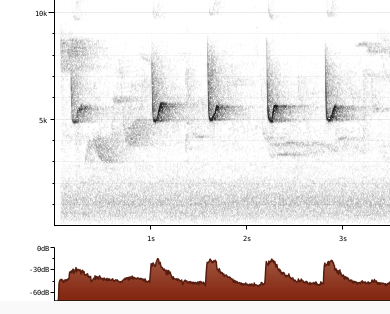
Ruf Eigenschaften:
Ruf Melodie: einnotig, langsam, Frequenz: 5-7 KHz,
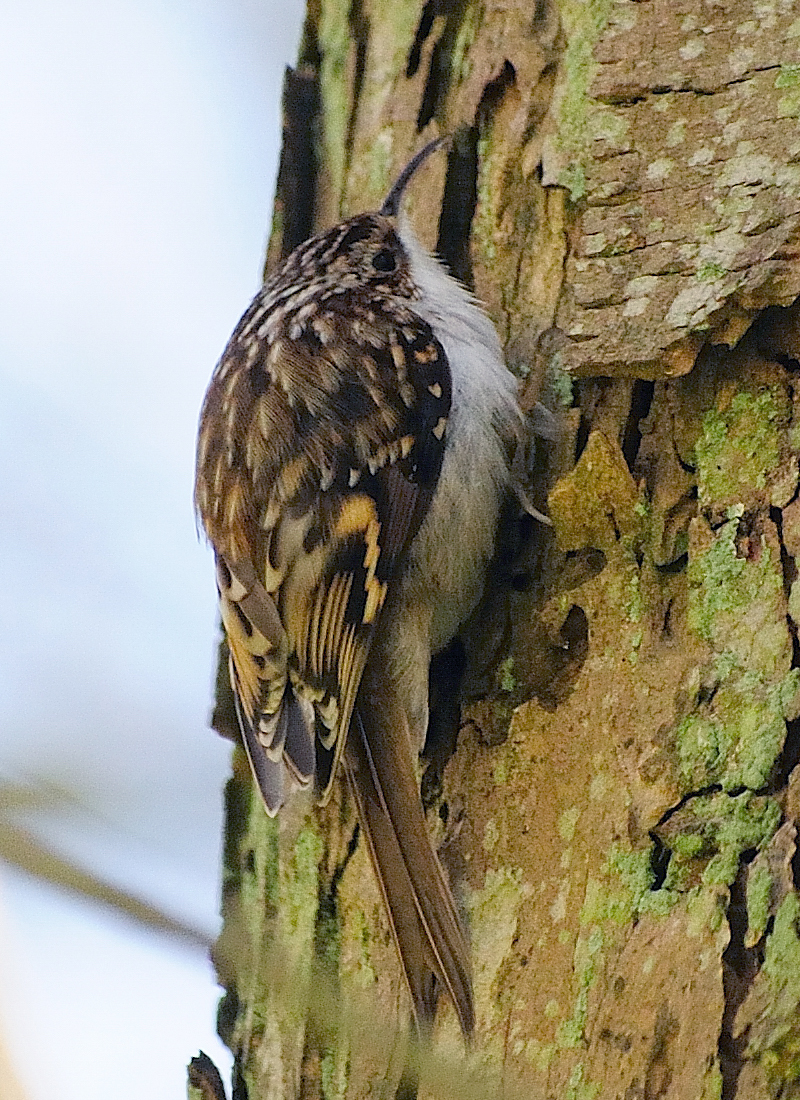
As seen creeping up a tree trunk Quelle: WIKIPEDIA
Wikimedia - European Treecreeper - Certhia_familiaris_-climbing_tree-8_(cropped_version).jpg
Zuerst beobachtet in 🇨🇭 an 2020-04-25.
Allgemein: ![]() Der Waldbaumläufer (Certhia familiaris) ist eine Vogelart der Gattung der Eigentlichen Baumläufer (Certhia) aus der Familie der Baumläufer (Certhiidae).
[more]
Der Waldbaumläufer (Certhia familiaris) ist eine Vogelart der Gattung der Eigentlichen Baumläufer (Certhia) aus der Familie der Baumläufer (Certhiidae).
[more]
Gesang: ![]() Lang u. klar! (Waldwege sind lang). Tonreihe im Ganzen absinkend, nur letzter Ton höher. [Link]
Lang u. klar! (Waldwege sind lang). Tonreihe im Ganzen absinkend, nur letzter Ton höher. [Link]
![]() Song a short, continuous three-part phrase. [Link]
Song a short, continuous three-part phrase. [Link]
Rufe: ![]() weniger scharf, „srih,“ weniger eindringlich als oben
[Link]
weniger scharf, „srih,“ weniger eindringlich als oben
[Link]
![]() Contact call a drawn, high-pitched "tzreeee". Similar to Goldcrest in timbre, but of longer duration with a vibrating and slightly rolling tone. Generally repeated in evenly paced, slow series (unlike Goldcrest). Each phrase starts with a few contact call-like notes followed by a Willow Warbler-like descending part, which then jumps to a few descending high notes to form a marked conclusion. Note that "mixed singers" are not uncommon in areas where both species of treecreepers occur. [Link]
Contact call a drawn, high-pitched "tzreeee". Similar to Goldcrest in timbre, but of longer duration with a vibrating and slightly rolling tone. Generally repeated in evenly paced, slow series (unlike Goldcrest). Each phrase starts with a few contact call-like notes followed by a Willow Warbler-like descending part, which then jumps to a few descending high notes to form a marked conclusion. Note that "mixed singers" are not uncommon in areas where both species of treecreepers occur. [Link]
Körperlich: Länge=12 cm,
Flügelspanne=17-21 cm,
Gewicht=8-11 g
Habitate:
Wald
Sieht ähnlich aus wie:
Gartenbaumläufer.
Gesang:
Ich sage: es klingt wie ein schneller, hoher Buchfink. Wikipedia sagt: Die kurze Gesangsstrophe ist eine abfallende, zum Ende wieder ansteigende Reihe von leisen Pfeiftönen und erinnert an die Lautäußerungen von Blaumeise und Fitis. The example at bird-song.ch is a series of 5 notes falling 3x and rising back 2x, then 5 or so fast falling notes.
Gesang Eigenschaften:
Eselsbrücke Sagging tree branch Melody: stereotypisch melodisch, langsam, Frequency: medium (1-5 KHz)
Ruf:
General: Wikipedia sagt: Sein Ruf klingt in etwa wie "siih" oder "tih".
Fairly regularly spaced single tseep at 7-9KHz.
Call: ![]() Contact call a drawn, high-pitched "tzreeee". Similar to Goldcrest in timbre, but of longer duration with a vibrating and slightly rolling tone. Generally repeated in evenly paced, slow series (unlike Goldcrest). [Link]
Contact call a drawn, high-pitched "tzreeee". Similar to Goldcrest in timbre, but of longer duration with a vibrating and slightly rolling tone. Generally repeated in evenly paced, slow series (unlike Goldcrest). [Link]
Ruf Eigenschaften:
Ruf Melodie: einnotig, langsam, Frequenz: 7-9 KHz,
Eichelhaeher for profile. 2020-04-17 08.48.34 Wald Fehraltorf
Zuerst beobachtet in 🇨🇭 an 2020-04-17.
Allgemein: ![]() Der Eichelhäher (Garrulus glandarius) ist ein Singvogel aus der Familie der Rabenvögel (Corvidae).
[more]
Der Eichelhäher (Garrulus glandarius) ist ein Singvogel aus der Familie der Rabenvögel (Corvidae).
[more]
Vokalisierung: ![]() Large repertoire. Many other social sounds. [Link]
Large repertoire. Many other social sounds. [Link]
Gesang: ![]() Quiet and varied subsong with mimicry, resembling a small passerine heard from both sexes. [Link]
Quiet and varied subsong with mimicry, resembling a small passerine heard from both sexes. [Link]
Rufe: ![]() Most heard call a short, drawn and very hoarse, raspy sound, often given in quick successions. Also a Buzzard-like, mewing "peeeaaa" (more drawn and less full tone than Siberian Jay). [Link]
Most heard call a short, drawn and very hoarse, raspy sound, often given in quick successions. Also a Buzzard-like, mewing "peeeaaa" (more drawn and less full tone than Siberian Jay). [Link]
Körperlich: Länge=34-35 cm,
Flügelspanne=52-58 cm,
Gewicht=140-190 g
Habitate:
Wald
Gesang:
Harsh crow-like call, or quiet questioning, 'grumbling', or plaintive cries.
Gesang Eigenschaften:
Melody: nicht musikalisch, schnell, Frequency: medium (1-5 KHz) Special sounds: Krächzen, Mimikry
Rufe:
1:
Typically harsh jay call. I would say a contact call usually means 'Here I am', answered by 'Good, here I am.' Listening to two jays in the Swiss mountains of Toggenburg, it sounded like 'HEY IDIOT, HERE I AM...WHERE THE HECK ARE YOU?' 'WHAT? YOU HAVEN'T FIGURE IT OUT? OF COURSE I'M OVER HERE. PEABRAIN.' On the other hand, anthropomorphism is always dangerous, usually completely wrong approach.
2:
We saw and heard a jay (Eichelhaeher) at the Pfaeffikersee imitating a common buzzard - very cool.
♫ Quelle: XENOCANTO
XC97136 - Eurasian Jay - Garrulus glandarius - imitating common buzzard.mp3
(Nachahmung vom Ruf eines anderen Vogels)
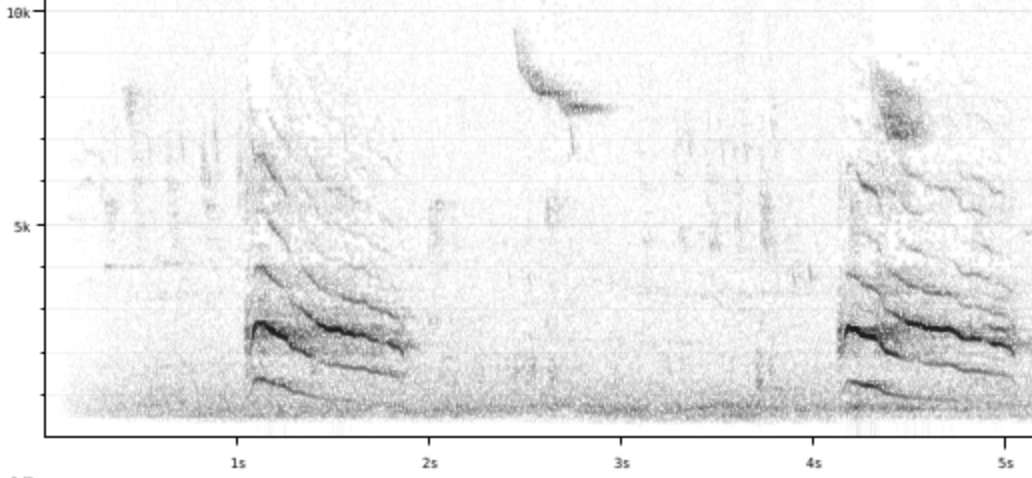
Ruf Eigenschaften:
Ruf Melodie: einnotig, langsam, Frequenz: medium (1-5 KHz), Spezielle Klänge: Raspel.
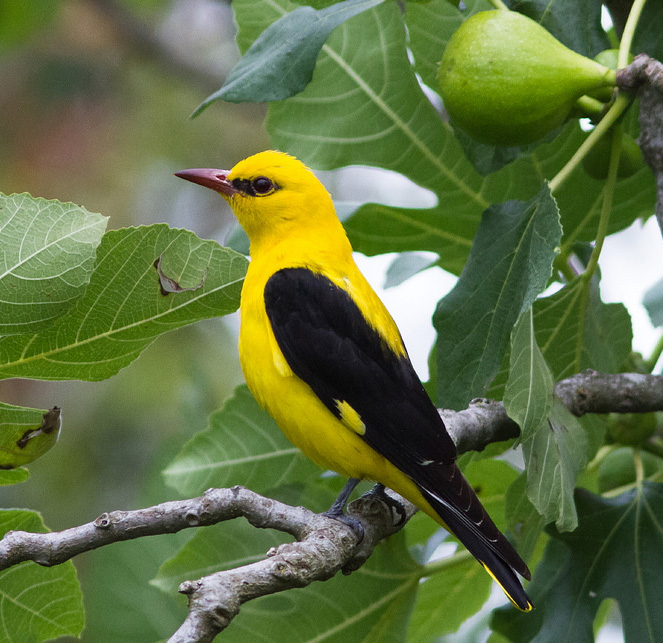
Wikimedia Eurasian golden oriole. Quelle: WIKIPEDIA
Wikimedia Eurasian golden oriole.jpg
Zuerst beobachtet in 🇨🇭 an 2020-05-25.
Pirol: auffälligen Sexualdimorphismus.
Wo/Habitat: lichter Auenwälder, Bruchwälder und gewässernaher Gehölze. Ebenso zählen Laub-, Misch- und Nadelwälder sowie Parks, große Gärten, Friedhöfe, Streuobstwiesen, hohe Obstbäume, Windschutzgürtel und Alleen zu seinen Brutgebieten, wo er sich überwiegend im Kronendach höherer Bäume aufhält.
Der Verbreitungsschwerpunkt liegt hier im kontinentaleren Osteuropa.
knapp amselgross;
Presence april 15 - September 15
https://www.vogelwarte.ch/de/voegel/voegel-der-schweiz/pirol
In Western Europe they prefer open broadleaf forests and plantations, copses, riverine forest, orchards, large gardens.They reside in Switzerland from mid-April to mid-September, breeding in mid-May to mid-July.
They predominate near the German and French borders, from Lake Constance to Geneva.
I want to try to see one at Neeracherried or Thurauen.
Geographie: ![]() Einzige Art der Oriolidae, die in Europa brutet.
[Link]
Einzige Art der Oriolidae, die in Europa brutet.
[Link]
Gesang: ![]() Varied repertoire, but song and common contact call very distinct. Song a series of 1-2 seconds long phrases of 3-5 yodeling, clear, fluting notes, interspersed with 2-3 second pauses. Tone very full-bodied, melodic and pleasing. [Link]
Varied repertoire, but song and common contact call very distinct. Song a series of 1-2 seconds long phrases of 3-5 yodeling, clear, fluting notes, interspersed with 2-3 second pauses. Tone very full-bodied, melodic and pleasing. [Link]
Rufe: ![]() Flötenrufen
Oft wird der Gesang allerdings vom Star treffend ähnlich nachgeahmt. [Link]
Flötenrufen
Oft wird der Gesang allerdings vom Star treffend ähnlich nachgeahmt. [Link]
![]() Contact call surprisingly different: A forced, drawn "weeackt", slightly resembling Jay, but less harsh, and much more nasal. Other sounds include a Wryneck-like warning call. [Link]
Contact call surprisingly different: A forced, drawn "weeackt", slightly resembling Jay, but less harsh, and much more nasal. Other sounds include a Wryneck-like warning call. [Link]
Körperlich: Länge=24 cm,
Flügelspanne=44-47 cm,
Gewicht=56-79 g
Habitate:
Wald
Gesang:
Weiches, tiefes Flöten. Meiner Meinung nach hat der Pirol eine wunderschoene Stimme aber gar keine Fantasie was Melodie betrifft - er sind immer die gleichen paar Noten.
Gesang Eigenschaften:
Melody: stereotypisch melodisch, langsam, Frequency: 0-1 KHz Singing season: 04-22 - 09-21
♫ Quelle: XENOCANTO
XC567973 eurasian golden oriole song.mp3
(Gesang)

Ruf:
3 somewhat harsh ascending notes, more melodic than a Eurasian jay call
♫ Quelle: XENOCANTO
XC565722 eurasian golden oriole call.mp3
(Ruf)

Ruf Eigenschaften:
Ruf Melodie: einfach rhythmisch, langsam, Frequenz: medium (1-5 KHz),
Präsenz: 04-15 - 09-15
Brut: 03-15 - 07-15
Migration rein: 04-15 - 06-10
Migration raus: 07-10 - 09-15
Profil Wikipedia eBird Vogelwarte BirdLife ZH ornitho.ch bird-song.ch Xeno-Canto NABU
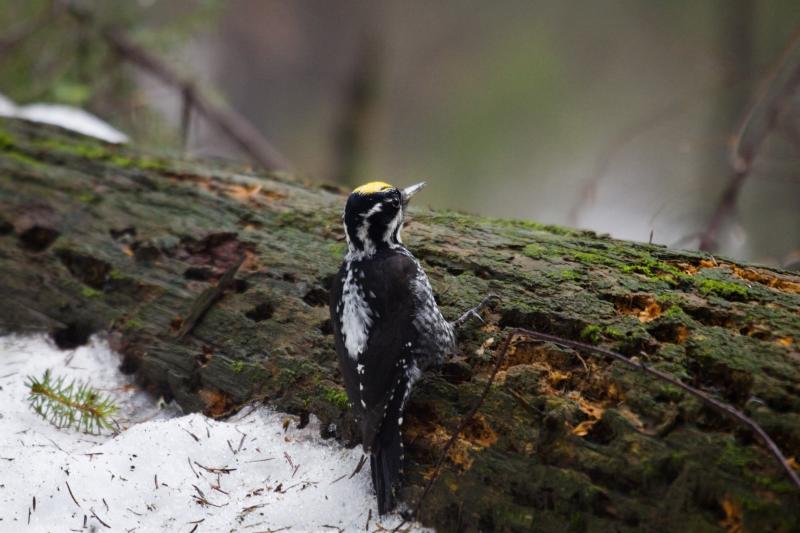
Männchen mit gut erkennbarem gelben Oberkopf. Von Alberto Chiarle - https://www.flickr.com/photos/alberto_chiarle/5373229161/, CC BY-SA 3.0, Link Quelle: WIKIPEDIA
Wikipedia Dreizehenspecht.jpg
Zuerst beobachtet in 🇨🇭 an 2021-08-02.
Behavior: ![]() Der Borkenkäferspezialist bevorzugt ungepflegte Fichtenwälder mit reichlich Totholz. [Portrait]
Der Borkenkäferspezialist bevorzugt ungepflegte Fichtenwälder mit reichlich Totholz. [Portrait]
Verhalten: ![]() Die Anwesenheit des heimlichen Dreizehenspechts wird oft übersehen. Er ist wenig scheu und fliegt kaum weg, wenn man sich ihm nähert. [Portrait]
Die Anwesenheit des heimlichen Dreizehenspechts wird oft übersehen. Er ist wenig scheu und fliegt kaum weg, wenn man sich ihm nähert. [Portrait]
Habitate:
Wald
Gesang:
Fast drumming, constant volume, longer than great spotted woodpecker's.
Gesang Eigenschaften:
Melody: einfach rhythmisch, schnell, Frequency: low (1-3 KHz) Special sounds: trommeln
♫ Dreizehenspecht trommelt Quelle: XENOCANTO
XC627431 dreizehenspecht drumming.mp3
(Trommeln)
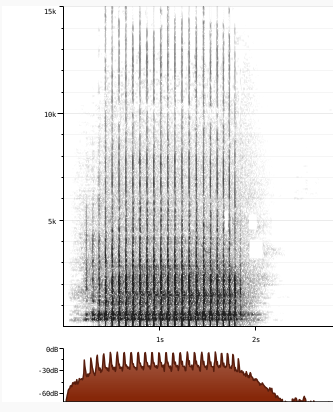
Ruf:
Behavior: ![]() Seine unauffälligen Rufe sind nicht laut und tönen ähnlich wie jene des Buntspechts. [Portrait]
Seine unauffälligen Rufe sind nicht laut und tönen ähnlich wie jene des Buntspechts. [Portrait]
♫ Quelle: XENOCANTO
XC498796 Dreizehenspecht call.mp3
(Ruf)

Ruf Eigenschaften:
Trommeln Ruf Melodie: einfach rhythmisch, langsam, Frequenz: low (1-3 KHz),
Buntspecht hoch im Baum im Wald 'Im Brand' 2020-04-25 07.57.12 Luppmen
Zuerst beobachtet in 🇨🇭 an 2020-04-12.
Haeufigste Spechtart in der Schweiz
Vokalisierung: ![]() It's frequent drumming is easily recognized by its short duration. [Link]
It's frequent drumming is easily recognized by its short duration. [Link]
Rufe: ![]() Typically it lasts 0.5 seconds, sometimes slightly longer. Contact call frequently hear throughout the year. A short hiccup "kek", sometimes in series. When excited this may escalate into a trill. [Link]
Typically it lasts 0.5 seconds, sometimes slightly longer. Contact call frequently hear throughout the year. A short hiccup "kek", sometimes in series. When excited this may escalate into a trill. [Link]
Körperlich: Länge=22-23 cm,
Flügelspanne=34-39 cm,
Gewicht=70-100 g
Habitate:
Wald
Gesang oder Rüfe ähnlich wie:
Ringdrossel.
Gesang:
Song: Other: ‘Drumming’ is the sound that Great Spotted Woodpeckers make by hammering their bills against dead wood 10-20 times over 2-3 seconds. The sound resonates in the dead wood and can be heard over large distances. This drumming acts as an advert and is used by Great spotted Woodpeckers and other woodpecker species instead of a song. [From the GardenBird web site]
Nabu: Manchmal, bei strahlendem Sonnenschein, fangen die Spechte schon im Dezember an zu trommeln. [NABU Vogel des Jahres 1997]
Call: Nabu: Das bekannteste Geräusch des schwarz-weißen Spechtes ist aber wohl sein kurzes, aber häufiges Trommeln. [Link]
![]() In a sonogram I can see about 13 taps in just over half a second, but you can never distinguish so many.
It's short but intense, and the second half trails off,
especially contrasted with the constant drumming of the three-toed woodpecker. [[Listen here.]]
In a sonogram I can see about 13 taps in just over half a second, but you can never distinguish so many.
It's short but intense, and the second half trails off,
especially contrasted with the constant drumming of the three-toed woodpecker. [[Listen here.]]
Gesang Eigenschaften:
Melody: nicht musikalisch, schnell, Frequency: low (1-3 KHz) Special sounds: trommeln Singing season: 01-01 - 06-30
♫ Great spotted woodpecker drumming Quelle: XENOCANTO
XC625181 buntspecht drumming.mp3
(Trommeln)
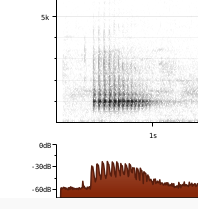
Ruf:
General: A chirping (that I couldn't associate in my mind with a woodpecker), repeated at somewhat irregular intervals of about a second
2023: klang in bird-song.ch Quiz wie eine lauter Haussperling
Call: Nabu: Der häufigste Ruf ist ein kurzes und spitzes „kix“. Ist ein Buntspecht aufgebracht, etwa durch einen Artgenossen, kann man ein schnelles Schnarren hören. [Link]
Great spotted woodpecker call
♫ Great spotted woodpecker call Quelle: XENOCANTO
XC200059 Great spotted woodpecker call.mp3
(Ruf)
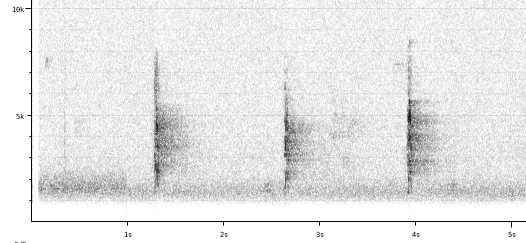
Ruf Eigenschaften:
Ruf Melodie: einnotig, langsam, Frequenz: 1-8 KHz,
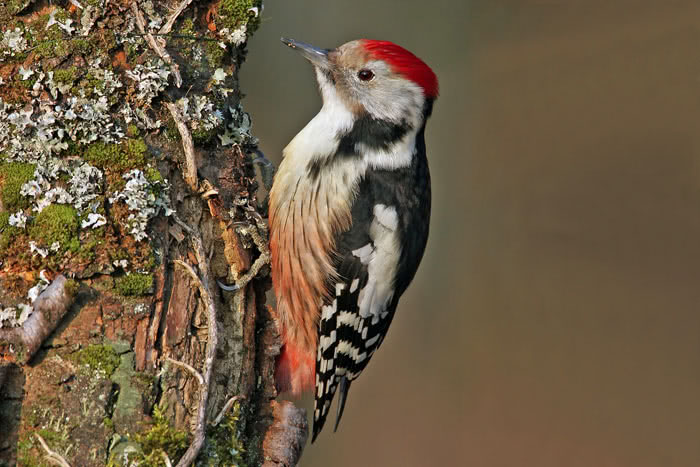
Vogelwarte Mittelspecht. Quelle: VOGELWARTE
Vogelwarte Mittelspecht.jpg
Habitat: ![]() Der Mittelspecht ist ein Habitatspezialist, der bei uns hauptsächlich ehemalige Mittelwälder mit zahlreichen Alteichen besiedelt. Der Bestand ist gefährdet und langfristig wird er sich nur halten können, wenn grossflächige Wälder mit der Eiche als Hauptbaumart bestehen bleiben. [Link]
Der Mittelspecht ist ein Habitatspezialist, der bei uns hauptsächlich ehemalige Mittelwälder mit zahlreichen Alteichen besiedelt. Der Bestand ist gefährdet und langfristig wird er sich nur halten können, wenn grossflächige Wälder mit der Eiche als Hauptbaumart bestehen bleiben. [Link]
Gesang: ![]() Im Gegensatz zu anderen Spechten trommelt der Mittelspecht nur sehr selten. [Link]
Im Gegensatz zu anderen Spechten trommelt der Mittelspecht nur sehr selten. [Link]
![]() Song is a series of short, mewing and nasal "peeaa peeaa peeaa ", where each syllable quickly rises in pitch, but the overall phrase is fairly constant. [Link]
Song is a series of short, mewing and nasal "peeaa peeaa peeaa ", where each syllable quickly rises in pitch, but the overall phrase is fairly constant. [Link]
Rufe: ![]() Contact and alarm call consists of a series of short "kitt" sounds, where the first syllable is clearer and distinctly in a higher pitch than the rest of the phrase. Seldom drums. [Link]
Contact and alarm call consists of a series of short "kitt" sounds, where the first syllable is clearer and distinctly in a higher pitch than the rest of the phrase. Seldom drums. [Link]
Körperlich: Länge=20-22 cm,
Flügelspanne=33-34 cm,
Gewicht=50-80 g
Habitate:
Wald
Gesang:
Automatically generated from Xeno-Canto recording
Gesang Eigenschaften:
Frequency:
♫ 2024-04-07 13 50 mittelspecht bei Seegräben, heavily edited with noise reduction, hipass, etc. 2024-04-07 13.50.00 (Gesang)

Ruf:
![]() Stattdessen ist in der Brutzeit das klagende Quäken zu hören, womit der Mittelspecht sein Revier markiert. [Link]
Stattdessen ist in der Brutzeit das klagende Quäken zu hören, womit der Mittelspecht sein Revier markiert. [Link]
♫ Quelle: XENOCANTO
XC624229 Mittelspecht call.mp3
(Ruf)
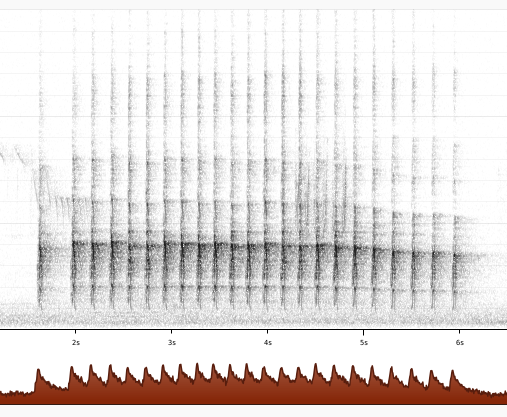
Ruf Eigenschaften:
Ruf Melodie: einfach rhythmisch, langsam, Frequenz: 0-4 KHz,
Profil Wikipedia eBird Vogelwarte BirdLife ZH ornitho.ch bird-song.ch Xeno-Canto BirdID NABU

Black Woodpecker adult and young By Alastair Rae from London, United Kingdom - Black Woodpecker, CC BY-SA 2.0. Quelle: WIKIPEDIA
Wikimedia Black Woodpecker adult and young.jpg
Zuerst beobachtet in 🇨🇭 an 2020-10-21.
Bisher gehört und später gesehen aber nie gut fotografiert
Aussehen und Identifizierung: ![]() The black woodpecker (Dryocopus martius) is a large woodpecker that lives in mature forests across the northern Palearctic. It is the sole representative of its genus in that region. Its range is expanding. It does not migrate. [Link]
The black woodpecker (Dryocopus martius) is a large woodpecker that lives in mature forests across the northern Palearctic. It is the sole representative of its genus in that region. Its range is expanding. It does not migrate. [Link]
Habitat: ![]() The black woodpecker is mainly found in forested regions, with a preference for extensive, mature woodland, including coniferous, tropical, subtropical and boreal forests. It is very widespread throughout mountainous and lowland forests. It is more likely to occur in marginal woods near human habitations during the non-breeding season. [Link]
The black woodpecker is mainly found in forested regions, with a preference for extensive, mature woodland, including coniferous, tropical, subtropical and boreal forests. It is very widespread throughout mountainous and lowland forests. It is more likely to occur in marginal woods near human habitations during the non-breeding season. [Link]
Vokalisierung: ![]() Most sounds diagnostic and very far reaching. Drumming very powerful and long (1.8 - 3 sec.) with slightly falling intensity and accelerated ending. Each beat clearly distinguishable as in Tree-toed Woodpecker, but duration much longer. [Link]
Most sounds diagnostic and very far reaching. Drumming very powerful and long (1.8 - 3 sec.) with slightly falling intensity and accelerated ending. Each beat clearly distinguishable as in Tree-toed Woodpecker, but duration much longer. [Link]
Gesang: ![]() Beide Geschlechter ähnlich Grünspecht aber klangvoller. „klückklückklück“ 10-20 Laute. Die „klück“ werden etwas von unten heraufgeholt, vor allem gegen den Schluss zu. Häufiger hört man „kliüüh“ von am Stamme sitzenden Vogel. Bei Platzwechsel ruft er „krükrükrü“.
[Link]
Beide Geschlechter ähnlich Grünspecht aber klangvoller. „klückklückklück“ 10-20 Laute. Die „klück“ werden etwas von unten heraufgeholt, vor allem gegen den Schluss zu. Häufiger hört man „kliüüh“ von am Stamme sitzenden Vogel. Bei Platzwechsel ruft er „krükrükrü“.
[Link]
![]() Song a quick series of "klee" calls resembling Green Woodpecker, but with a purer tone and upward infliction at end of each syllable. [Link]
Song a quick series of "klee" calls resembling Green Woodpecker, but with a purer tone and upward infliction at end of each syllable. [Link]
Rufe: ![]() Drumming:
Drumming:
Flight call a characteristic resonant trill "krrreekrrreekrrreekrrree". A characteristic short, sharp and plaintive "keeaaa" with descending pitch often uttered when excited. A few slower drawn-out introductory calls before the phrase gets going is diagnostic. [Link]
Körperlich: Länge=45-57 cm,
Flügelspanne=64-68 cm,
Gewicht=290-370 g
Habitate:
Wald
Gesang:
Automatically generated from Xeno-Canto recording
Gesang Eigenschaften:
Frequency:
♫ Quelle: BirdNet
20201021_151308 birdnet 1021 Reitenbachholzweg bei Rumlikon - Black woodpecker plus great spotted woodpecker - Oberreitenbachholzweg, Rumlikon.mp3
2020-10-21 15.13.08 Oberreitenbachholzweg, Rumlikon (Gesang)
Rufe:
1:
General: A loud unearthly call on a single unwavering note.
Erschrenkender Ruf
♫ Erschrenkender Ruf Source as noted in xeno-canto: Recordist Bodo Sonnenburg
2021-10-11 07:26
Latitude 52.2333
Longitude 13.8365
Location Oder-Spree (near Storkow (Mark)), Brandenburg
Country Germany
Elevation 40 m Quelle: XENOCANTO
XC679746 - Black Woodpecker - Dryocopus martius.mp3
(Ruf)
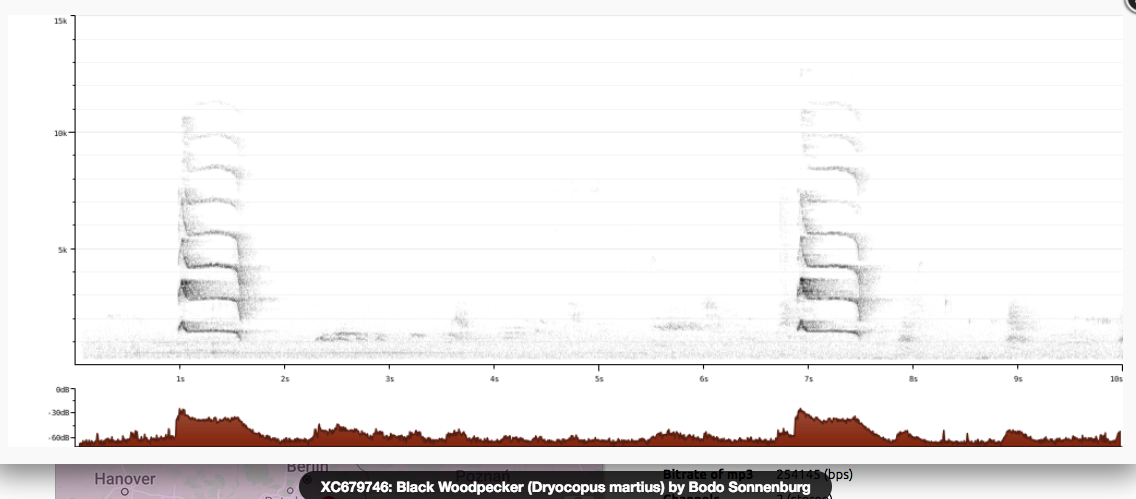
2:
Describe drumming here, cf to other peckers!
Ruf Eigenschaften:
Ruf Melodie: einnotig, langsam, Frequenz: 1-8 KHz,
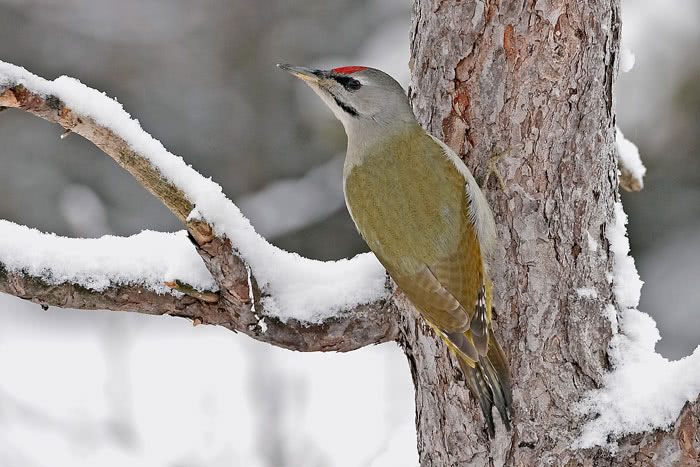
Vogelwarte Grauspecht. Note that it's quite green despite its name. Quelle: VOGELWARTE
Vogelwarte Grauspecht.jpg
Verhalten: ![]() Der Grauspecht gehört mit dem Grünspecht zu den «Erdspechten», die ihre Nahrung vorwiegend auf dem Boden suchen. Obwohl er fast so gross ist wie der Grünspecht, ist der heimlicher lebende Grauspecht ungleich schwieriger zu lokalisieren. Am ehesten verrät er sich durch die fallende, etwas melancholisch wirkende Rufreihe. Über seine Lebensweise ist vergleichsweise wenig bekannt. [Link]
Der Grauspecht gehört mit dem Grünspecht zu den «Erdspechten», die ihre Nahrung vorwiegend auf dem Boden suchen. Obwohl er fast so gross ist wie der Grünspecht, ist der heimlicher lebende Grauspecht ungleich schwieriger zu lokalisieren. Am ehesten verrät er sich durch die fallende, etwas melancholisch wirkende Rufreihe. Über seine Lebensweise ist vergleichsweise wenig bekannt. [Link]
Gesang: ![]() Deutlich abfallende Tonreihe. 4-10 Töne. Absinken beginnt
gewöhnlich erst mit dem dritten oder vierten Ton und wird etwas langsamer.
Klingt etwas klagend (moll). Vor allem gegen den Schluss. Kann nachgepfiffen werden. (beim Grünspecht nicht )
[Link]
Deutlich abfallende Tonreihe. 4-10 Töne. Absinken beginnt
gewöhnlich erst mit dem dritten oder vierten Ton und wird etwas langsamer.
Klingt etwas klagend (moll). Vor allem gegen den Schluss. Kann nachgepfiffen werden. (beim Grünspecht nicht )
[Link]
Habitate:
Wald
Gesang:
Drumming in lieu of song. Fast, constant, somehow less harsh than great and middle spotted woodpeckers.
Gesang Eigenschaften:
Melody: einfach rhythmisch, schnell, Frequency: 0-4 KHz Special sounds: trommeln
♫ Quelle: XENOCANTO
XC552636 Kleinspecht drumming.mp3
(Trommeln)
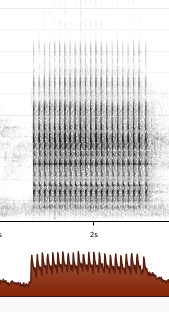
Ruf:
In the FOK course, Christina said he sounds like he's running out of gas, which is a great description.
♫ Quelle: XENOCANTO
XC623125 grauspecht call.mp3
(Ruf)
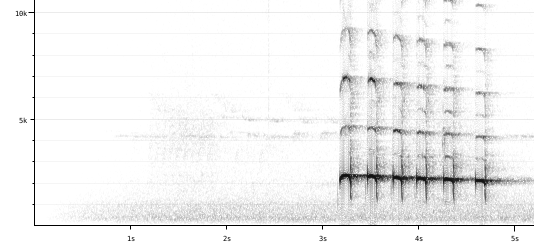
Ruf Eigenschaften:
Ruf Melodie: einfach rhythmisch, langsam, Frequenz: high (3-9 KHz),
Zuerst beobachtet in 🇨🇭 an 2020-11-08.
In the FOK course, Tom mentioned that his nephew said it should be called the Buntspecht, since it has so many colors.
Da es v.a. Ameisen frisst, trommelt es nicht viel, so weit ich mich erinnere, daher ist es hier nicht beschrieben. Xenocanto hat auch nichts.
Aussehen und Identifizierung: ![]() Der Grünspecht fällt neben dem laut lachenden Balzruf auch durch den wellenförmigen Flug auf, bei dem er die Flügel zwischen zwei Schlagphasen ganz an den Körper anlegt. Neben dem Wendehals ist er unter den Spechtarten Europas am stärksten auf Ameisen spezialisiert. Er besitzt eine mehr als 10 Zentimeter lange Zunge, die klebrig und an der Spitze mit Widerhaken versehen ist. [Link]
Der Grünspecht fällt neben dem laut lachenden Balzruf auch durch den wellenförmigen Flug auf, bei dem er die Flügel zwischen zwei Schlagphasen ganz an den Körper anlegt. Neben dem Wendehals ist er unter den Spechtarten Europas am stärksten auf Ameisen spezialisiert. Er besitzt eine mehr als 10 Zentimeter lange Zunge, die klebrig und an der Spitze mit Widerhaken versehen ist. [Link]
Gesang: ![]() Helles Lachen. Weiche, oft leicht abfallende Tonreihe. Variabel in Lautstärke und Silbenzahl. je nach Stimmung. Wenn abfallend dann vom Anfang der Rufreihe an. Auch dreisilbig „kiäckkiäckkiäck“.
[Link]
Helles Lachen. Weiche, oft leicht abfallende Tonreihe. Variabel in Lautstärke und Silbenzahl. je nach Stimmung. Wenn abfallend dann vom Anfang der Rufreihe an. Auch dreisilbig „kiäckkiäckkiäck“.
[Link]
![]() Song similar to Grey-headed Woodpecker, but not as soft and fluty. Each phrase consist of a series of short "klee", with a laughing quality. Pitch drops slightly throughout the phrase, but not as markedly as in Grey-headed, and tempo is fairly constant (no ritardando). [Link]
Song similar to Grey-headed Woodpecker, but not as soft and fluty. Each phrase consist of a series of short "klee", with a laughing quality. Pitch drops slightly throughout the phrase, but not as markedly as in Grey-headed, and tempo is fairly constant (no ritardando). [Link]
Rufe: ![]() Short "kek" calls when excited and in flight. Drumming of 1.5 seconds duration with decelerating tempo, but not often heard. Another call is similar to Black Woodpecker; a series of resonant "klit-klit-klit-klit-klit-klit", but is less clear, has a more determined start and has less obvious rising pitch at the end of each syllable. [Link]
Short "kek" calls when excited and in flight. Drumming of 1.5 seconds duration with decelerating tempo, but not often heard. Another call is similar to Black Woodpecker; a series of resonant "klit-klit-klit-klit-klit-klit", but is less clear, has a more determined start and has less obvious rising pitch at the end of each syllable. [Link]
Körperlich: Länge=31-33 cm,
Flügelspanne=40-42 cm,
Gewicht=150-220 g
Habitate:
Wald
Gesang:
Spooky laugh.
Gesang Eigenschaften:
Melody: nicht musikalisch, langsam, Frequency: 1-6 KHz
Ruf:
Unheimliches Lachen.
♫ Quelle: XENOCANTO
XC627157 Gruenspecht laughing call.mp3
(Ruf)
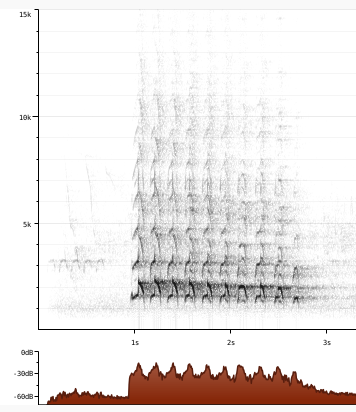
Ruf Eigenschaften:
Ruf Melodie: einfach rhythmisch, langsam, Frequenz: high (3-9 KHz),
Kleinspecht am luppmen. Never saw one until after a heavy snowfall one checked out the trees along the Luppmen 2021-01-16 12.56.16 Luppmen
Zuerst beobachtet in 🇨🇭 an 2021-01-16.
Bisher gesehen aber nicht gehört!
Aussehen und Identifizierung: ![]() The smallest European woodpecker. ... From its small size and its habit of spending most of its time in the tops of tall trees in woods and parks, this little woodpecker is often overlooked, but if sighted on a trunk
it may at once be identified by the broad barring on the wings and narrower bars across the lower back. [Link]
The smallest European woodpecker. ... From its small size and its habit of spending most of its time in the tops of tall trees in woods and parks, this little woodpecker is often overlooked, but if sighted on a trunk
it may at once be identified by the broad barring on the wings and narrower bars across the lower back. [Link]
![]() Der Kleinspecht ist der Zwerg unter den europäischen Spechten.
Er macht sich im Frühjahr mit hohen Rufreihen und gleichmässigen Trommelwirbeln bemerkbar. [Link]
Der Kleinspecht ist der Zwerg unter den europäischen Spechten.
Er macht sich im Frühjahr mit hohen Rufreihen und gleichmässigen Trommelwirbeln bemerkbar. [Link]
Habitat: ![]() As above: spend(s) most of its time in the tops of tall trees [Link]
As above: spend(s) most of its time in the tops of tall trees [Link]
Vokalisierung: ![]() Frequently drums in quite long series. Much longer than Great Spotted, and without ritardando. [Link]
Frequently drums in quite long series. Much longer than Great Spotted, and without ritardando. [Link]
Rufe: ![]() Most common call a series of merlin-like "ke-ke-ke-ke-ke-ke" given at fairly stable pitch, and less hoarse than Merlin. Differs from Wryneck in lacking marked rise and fall in pitch, and being less plaintive. [Link]
Most common call a series of merlin-like "ke-ke-ke-ke-ke-ke" given at fairly stable pitch, and less hoarse than Merlin. Differs from Wryneck in lacking marked rise and fall in pitch, and being less plaintive. [Link]
Körperlich: Länge=14-15 cm,
Flügelspanne=25-27 cm,
Gewicht=17-25 g
Habitate:
Wald
Gesang:
Drumming in lieu of song. Fast, constant.
Gesang Eigenschaften:
Melody: einfach rhythmisch, schnell, Frequency: 0-4 KHz Special sounds: trommeln
♫ Quelle: XENOCANTO
XC552636 Kleinspecht drumming.mp3
(Trommeln)

Ruf:
Vogelwarte wie oben..hohe Rufreihen
♫ Quelle: XENOCANTO
XC625101 Kleinspecht call.mp3
(Ruf)
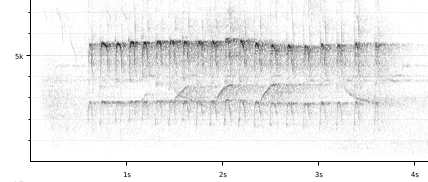
Ruf Eigenschaften:
Ruf Melodie: einfach rhythmisch, schnell, Frequenz: high (3-9 KHz),